Canon K30259 USB Bluetooth Transmitter User Manual 2
Canon Inc USB Bluetooth Transmitter Users Manual 2
Canon >
Contents
- 1. User manual 1 of 4
- 2. User manual 2 of 4
- 3. User manual 3 of 4
- 4. User manual 4 of 4
User manual 2 of 4
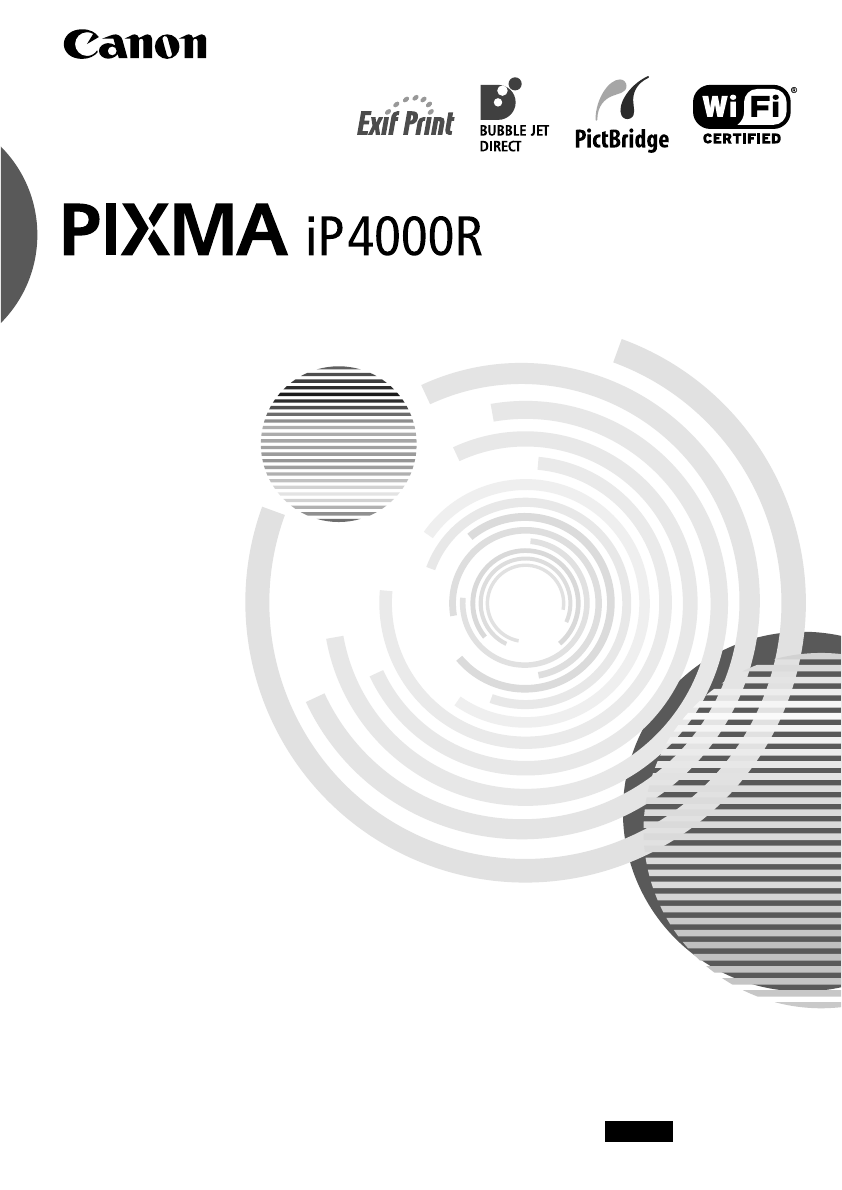
Setup Guide
QA7-3430-V02
BE
Photo Printer
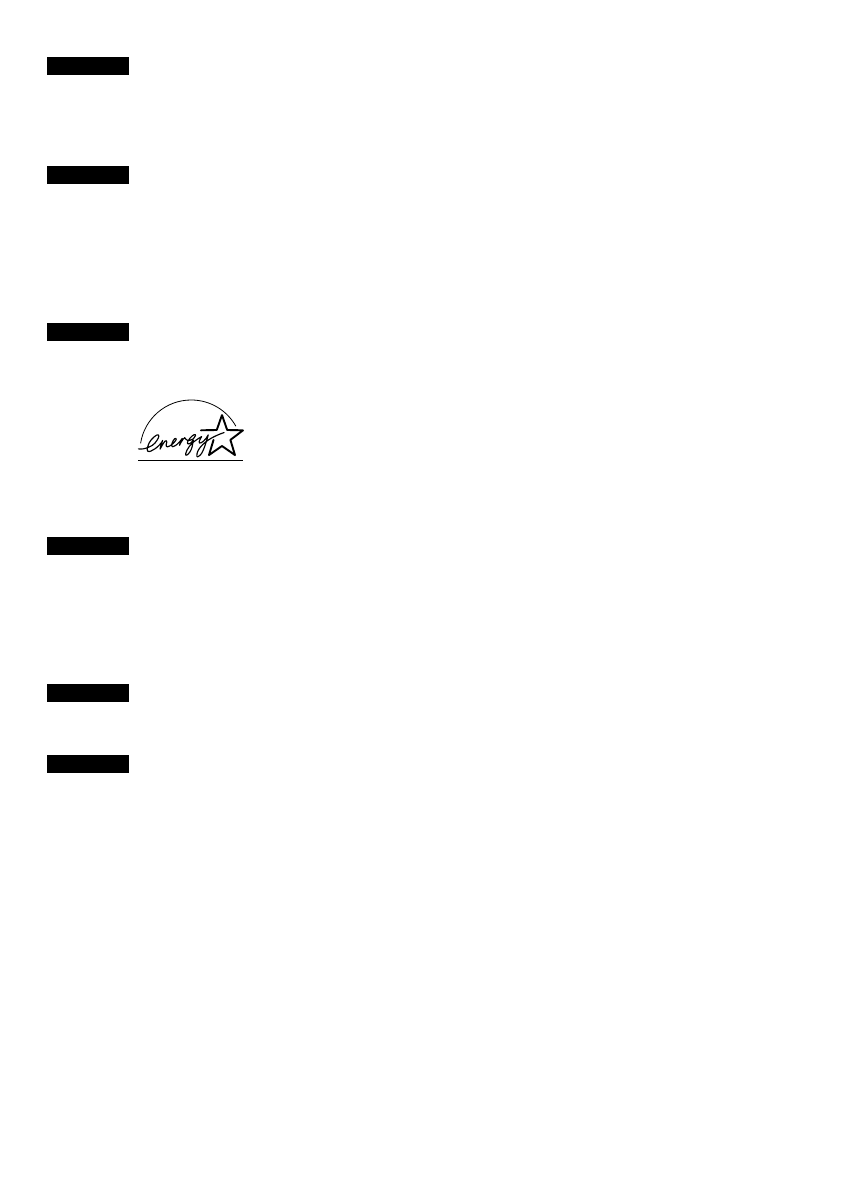
Exif Print
This printer supports ExifPrint.
Exif Print is a standard for enhancing the communication between digital cameras and printers. By
connecting to an Exif Print-compliant digital camera, the camera’s image data at the time of shooting is
used and optimized, yielding extremely high quality prints.
Canadian Radio Interference Regulations
This digital apparatus does not exceed the Class B limits for radio noise emissions from a digital
apparatus as set out in the interference-causing equipment standard entitled “Digital Apparatus,”
ICES-003 of the Industry Canada.
Cet appareil numérique respecte les limites de bruits radioélectriques applicables aux appareils
numériques de Classe B prescrites dans la norme sur le matériel brouilleur NMB-003 d'Industrie
Canada intitulée « Appareils numériques ».
International ENERGY STAR® Program
As an ENERGY STAR® Partner, Canon Inc. has determined that this product meets the ENERGY
STAR guidelines for efficiency.
The International ENERGY STAR® Office Equipment Program is a global program
that promotes energy saving through the use of computer and other office equipment.
The program backs the development and dissemination of products with functions
that effectively reduce energy consumption. It is an open system in which business
can participate voluntarily. The targeted products are office equipment such as com-
puters, monitors, printers, faxes and copiers.
Their standards and logos are uniform among participating nations.
Power Requirements
Never use a power supply voltage other than that supplied in the country of purchase. Using the incor-
rect voltage could cause a fire or electric shock. The correct power supply voltages and frequencies are
as follows:
AC 110-120V, 50-60Hz
AC 220-240V, 50-60Hz
Conformity declaration for R&TTE
We, Canon hereby declare that this equipment (printer) PIXMA iP4000R is in compliance with the
essential requirements and other relevant provisions of Directive 1999/5/EC.
FCC Radiation Exposure Statement
This equipment complies with FCC radiation exposure limits set forth for at uncontrolled equipment.
This equipment should be installed and operated with minimum distance at least 20cm between the
radiator and persons body (excluding extremities: hands, wrists, feet and legs) and must not be
co-located or operated with any other antenna or transmitter.
Printer Model: K10245 (iP4000R)
Z020

1
Table of Contents
Preface . . . . . . . . . . . . . . . . . . . . . . . . . . . . . . . . . . . . . . . . . . . . . . . . . . . . . . 2
Introduction . . . . . . . . . . . . . . . . . . . . . . . . . . . . . . . . . . . . . . . . . . . . . . . . . . . . . . . . . . . . . . . . . . . 2
Setup Outline. . . . . . . . . . . . . . . . . . . . . . . . . . . . . . . . . . . . . . . . . . . . . . . . . . . . . . . . . . . . . . . . . . 3
Shipping Materials . . . . . . . . . . . . . . . . . . . . . . . . . . . . . . . . . . . . . . . . . . . . . . . . . . . . . . . . . . . . . . 4
Confirming Your Connection Type. . . . . . . . . . . . . . . . . . . . . . . . . . . . . . . . 5
Connecting over Wireless LAN via an Access Point . . . . . . . . . . . . . . . . . . . . . . . . . . . . . . . . . . . . 6
Connecting over Wired LAN . . . . . . . . . . . . . . . . . . . . . . . . . . . . . . . . . . . . . . . . . . . . . . . . . . . . . . 7
Connecting with USB Connection . . . . . . . . . . . . . . . . . . . . . . . . . . . . . . . . . . . . . . . . . . . . . . . . . . 7
Using both USB Cable and Wireless LAN Connections . . . . . . . . . . . . . . . . . . . . . . . . . . . . . . . . . 8
Using both USB Cable and Wired LAN Connections . . . . . . . . . . . . . . . . . . . . . . . . . . . . . . . . . . . 8
Setting Up . . . . . . . . . . . . . . . . . . . . . . . . . . . . . . . . . . . . . . . . . . . . . . . . . . . . 9
Installing the Print Head. . . . . . . . . . . . . . . . . . . . . . . . . . . . . . . . . . . . . . . . . . . . . . . . . . . . . . . . . . 9
Installing the Ink Tanks . . . . . . . . . . . . . . . . . . . . . . . . . . . . . . . . . . . . . . . . . . . . . . . . . . . . . . . . . 12
Loading Paper . . . . . . . . . . . . . . . . . . . . . . . . . . . . . . . . . . . . . . . . . . . . . . . . . . . . . . . . . . . . . . . . 14
Confirming the Setup Procedure . . . . . . . . . . . . . . . . . . . . . . . . . . . . . . . . 15
Using the Printer for the First Time . . . . . . . . . . . . . . . . . . . . . . . . . . . . . . . . . . . . . . . . . . . . . . . . 15
Using the Printer Already Connected to a Network . . . . . . . . . . . . . . . . . . . . . . . . . . . . . . . . . . . . 15
Setting Up the Printer and the Computer . . . . . . . . . . . . . . . . . . . . . . . . . 16
Before Setup . . . . . . . . . . . . . . . . . . . . . . . . . . . . . . . . . . . . . . . . . . . . . . . . . . . . . . . . . . . . . . . . . 16
First-time Setup for Use over Wireless LAN . . . . . . . . . . . . . . . . . . . . . . . . . . . . . . . . . . . . . . . . . 19
First-time Setup for Use over Wired LAN . . . . . . . . . . . . . . . . . . . . . . . . . . . . . . . . . . . . . . . . . . . 31
Setting Up for Use with USB Connection . . . . . . . . . . . . . . . . . . . . . . . . . . . . . . . . . . . . . . . . . . . 39
Setting Up an Additional Computer to Use a Printer Already Connected to a Network. . . . . . . . . 45
Aligning the Print Head . . . . . . . . . . . . . . . . . . . . . . . . . . . . . . . . . . . . . . . . . . . . . . . . . . . . . . . . . 51
Basic Operations . . . . . . . . . . . . . . . . . . . . . . . . . . . . . . . . . . . . . . . . . . . . . 55
Printing with Windows . . . . . . . . . . . . . . . . . . . . . . . . . . . . . . . . . . . . . . . . . . . . . . . . . . . . . . . . . . 55
Printing with Macintosh . . . . . . . . . . . . . . . . . . . . . . . . . . . . . . . . . . . . . . . . . . . . . . . . . . . . . . . . . 58
Print Head Maintenance . . . . . . . . . . . . . . . . . . . . . . . . . . . . . . . . . . . . . . . 60
Appendix. . . . . . . . . . . . . . . . . . . . . . . . . . . . . . . . . . . . . . . . . . . . . . . . . . . . 62
Printing Photographs Directly from a Digital Camera . . . . . . . . . . . . . . . . . . . . . . . . . . . . . . . . . . 62
Notes on Handling the USB Interface (for Windows Users) . . . . . . . . . . . . . . . . . . . . . . . . . . . . . 67
Printing and Initializing Network Settings. . . . . . . . . . . . . . . . . . . . . . . . . . . . . . . . . . . . . . . . . . . .67
For Further Details... . . . . . . . . . . . . . . . . . . . . . . . . . . . . . . . . . . . . . . . . . . . . . . . . . . . . . . . . . . . 68
Troubleshooting. . . . . . . . . . . . . . . . . . . . . . . . . . . . . . . . . . . . . . . . . . . . . . 70
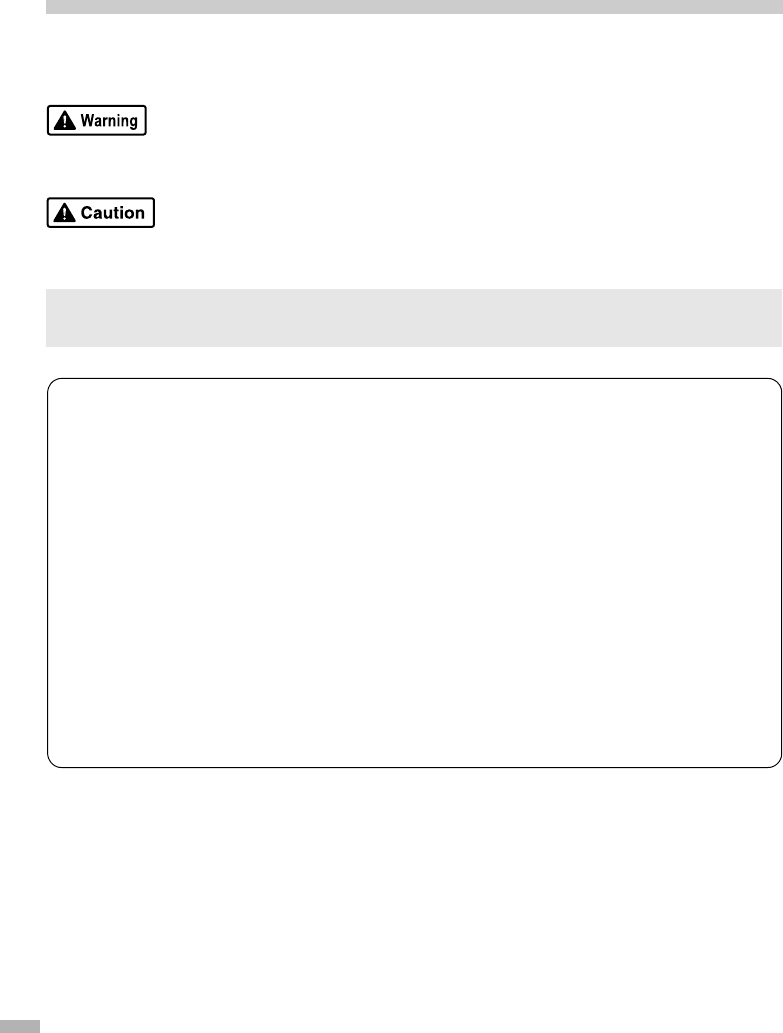
2
Preface
Introduction
Thank you for purchasing a Canon Bubble Jet Printer.
This Setup Guide uses the following symbols to indicate important information. Always observe the
instructions indicated by these symbols.
Instructions that, if ignored, could result in death or serious personal injury caused by incorrect
operation of the equipment. These must be observed for safe operation.
Instructions that, if ignored, could result in personal injury or material damage caused by incorrect
operation of the equipment. These must be observed for safe operation.
Also read the Safety Precautions in the
User’s Guide
. Observe the warnings and cautions to avoid
personal injury or damage to the printer.
Trademark Notices
• Canon is a registered trademark of Canon Inc.
• BJ is a trademark of Canon Inc.
• PIXMA is a trademark of Canon Inc.
• Microsoft
®
and Windows
®
are registered trademarks of Microsoft Corporation in the U.S. and other
countries.
• Microsoft
®
Windows
®
XP, Microsoft
®
Windows
®
2000, Microsoft
®
Windows
®
Millennium Edition,
and Microsoft
®
Windows
®
98 are expressed respectively as Windows XP, Windows 2000, Windows
Me, and Windows 98 in this
Setup Guide
.
• Apple, Mac, and Macintosh are trademarks of Apple Computer, Inc., registered in the U.S. and other
countries.
• Wi-Fi is a registered trademark of the Wi-Fi Alliance.
• Wi-Fi CERTIFIED is a certification mark of the Wi-Fi Alliance.
• All other trademarks and registered trademarks appearing in this
Setup Guide
are the property of their
respective owners.
Copyright ©2004 CANON INC.
All rights reserved. No part of this publication may be transmitted or copied in any form whatsoever
without the express written permission.
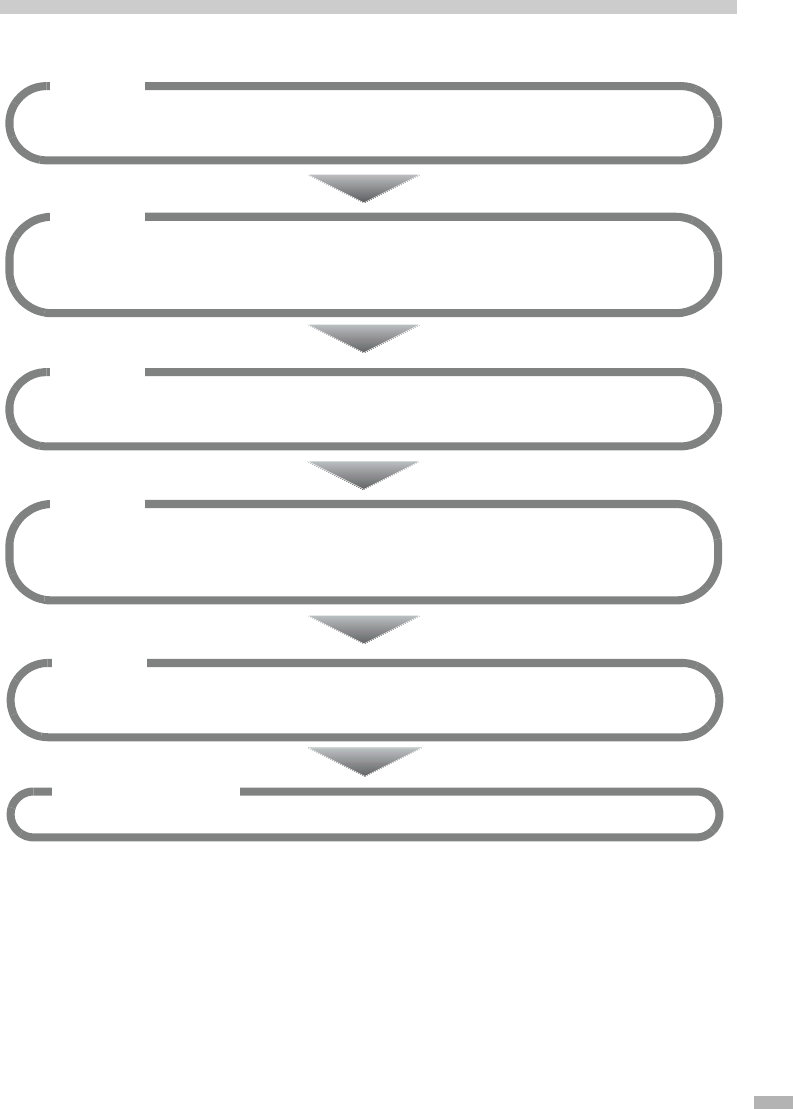
3
Setup Outline
Follow the steps below to start using the printer.
Check the supplied material. (see page 4)
Make sure the supplied items are included.
Step 1
Set the printer. (see page 9)
Place the printer and install the print head and the ink tanks.
Step 3
Step 5
Setup complete
Set up the printer and the computer. (see page 16)
Install the driver to use the printer and the software to connect it to a network.
The printer is now ready for use.
Step 2
Confirm the type of your connection. (see page 5)
There are several ways to connect the printer and your computer.
Decide on a connection type that matches your network setup.
Step 4
Confirm setup procedure. (see page 15)
Setup procedure differs depending on the type of your connection.
Make sure you know which setup procedure to perform.

4
Shipping Materials
Check that all the following items are in the box. If anything is missing or is damaged, contact your Canon
Service Representative.
Printer
Setup Software & User’s Guide CD-ROM
Setup Guide
Print Head
5 Ink Tanks
USB cable
To use the printer over wireless LAN, you need an access point. To use the printer over wired LAN, you
need an ethernet cable (and a hub, if you are connecting multiple computers). Purchase them separately as
necessary.
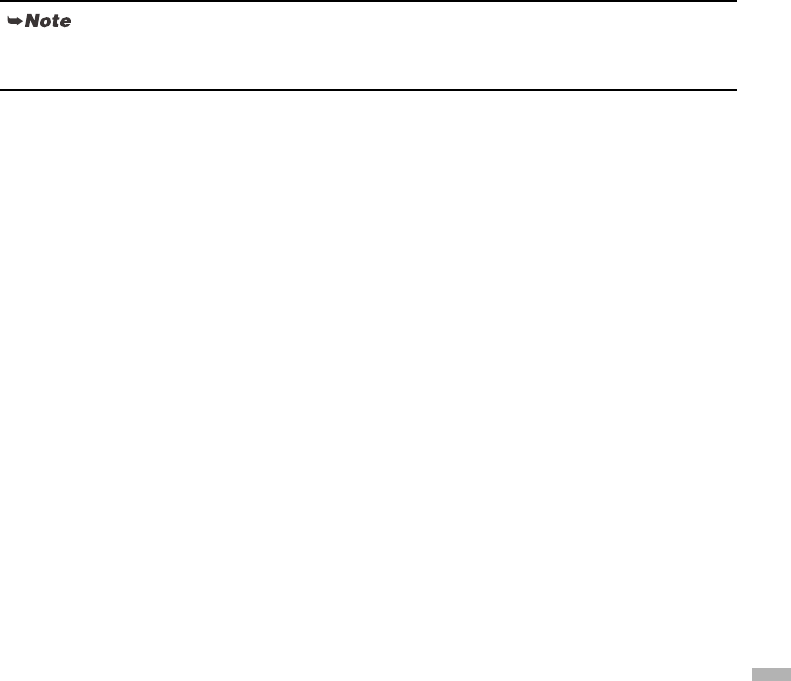
5
Confirming Your Connection
Type
If your printer is connected to a network, it can be shared by multiple computers.
This printer can be used over wireless or wired LAN, as well as with USB connection.
Connection type available for this printer are as follows.
• wireless LAN via an access point (see page 6)
• wired LAN (see page 7)
• USB connection (see page 7)
• combination of USB connection and wireless LAN (see page 8)
• combination of USB connection and wired LAN (see page 8)
To connect to the printer in a certain connection type, it must be available to your computer network setup in
the first place. Before starting setup, make sure you know the type of connection available to your computer,
and decide on a connection type for your printer.
Refer to the manuals of your network devices for necessary information. In an office setup, consult
your network administrator.
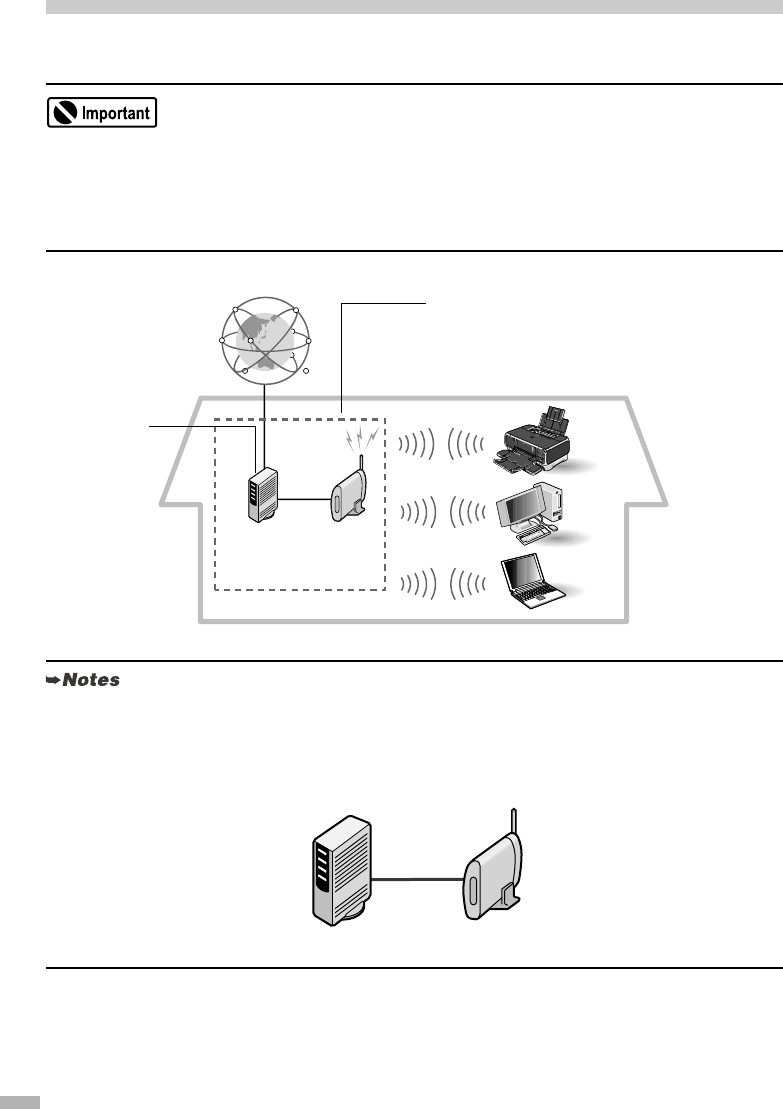
6
Connecting over Wireless LAN via an Access Point
Your computer communicates with the printer via an access point (the infrastructure mode). To share the
printer among multiple computers, connect them to the access point.
To set up the printer for use over wireless LAN, see “First-time Setup for Use over Wireless LAN” on
page 19 after you finished setting the printer.
• When using this printer in a wireless LAN setup, use the infrastructure mode. It does not support
the ad-hoc mode.
• An access point is needed to set up the infrastructure mode.
• If you connect to a network that is not protected with security measures, there is a risk of disclosing
data such as your personal information to a third party.
• A wireless LAN card or adapter must be installed in your computer to connect your computer to the
wireless LAN.
• A variant is the wireless LAN setup shown below, where your wireless LAN access point has the
router function, instead of your Internet connection device, such as a broadband modem. The type
of device in use in your network may vary. Refer to the manual of your device for details.
• The printer and the router need to be in the same network.
Broadband
modem with
router
Wireless LAN
access point
(without router)
The Internet
Wireless LAN
Wireless LAN
Wireless LAN
Connects to
the Internet
The printer communicates
with your computer(s) via
the access point
Broadband
modem without
router
Wireless LAN
access point
(with router)
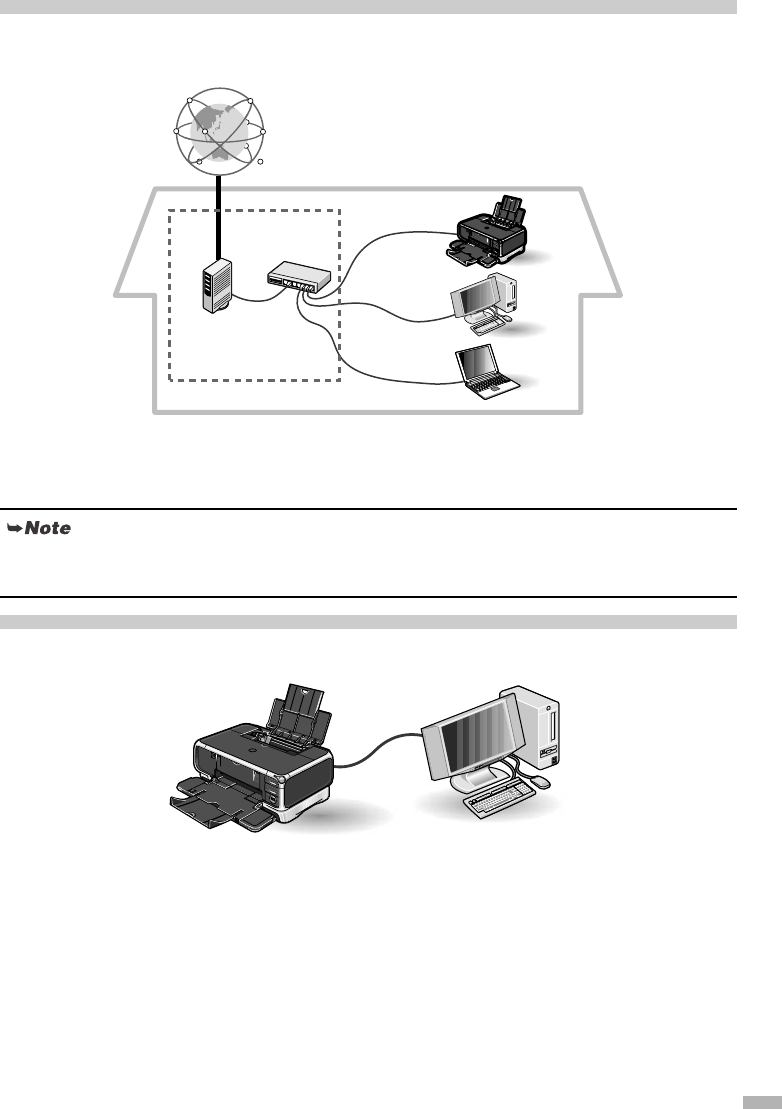
7
Connecting over Wired LAN
Your computer communicates with the printer via an Ethernet network.
To set up the printer for use over wired LAN, see “First-time Setup for Use over Wired LAN” on page 31
after you finished setting the printer.
Connecting with USB Connection
Your computer communicates with the printer via a USB cable.
To set up the printer for use with USB connection, see “Setting Up for Use with USB Connection” on
page 39 after you finished setting the printer.
Your hub may have the router function. The type of device in use in your network may vary. Refer to
the manual of your device for details.
Broadband
modem with
router
Hub
The Internet
Ethernet cable
Ethernet cable
Ethernet cable
USB Cable
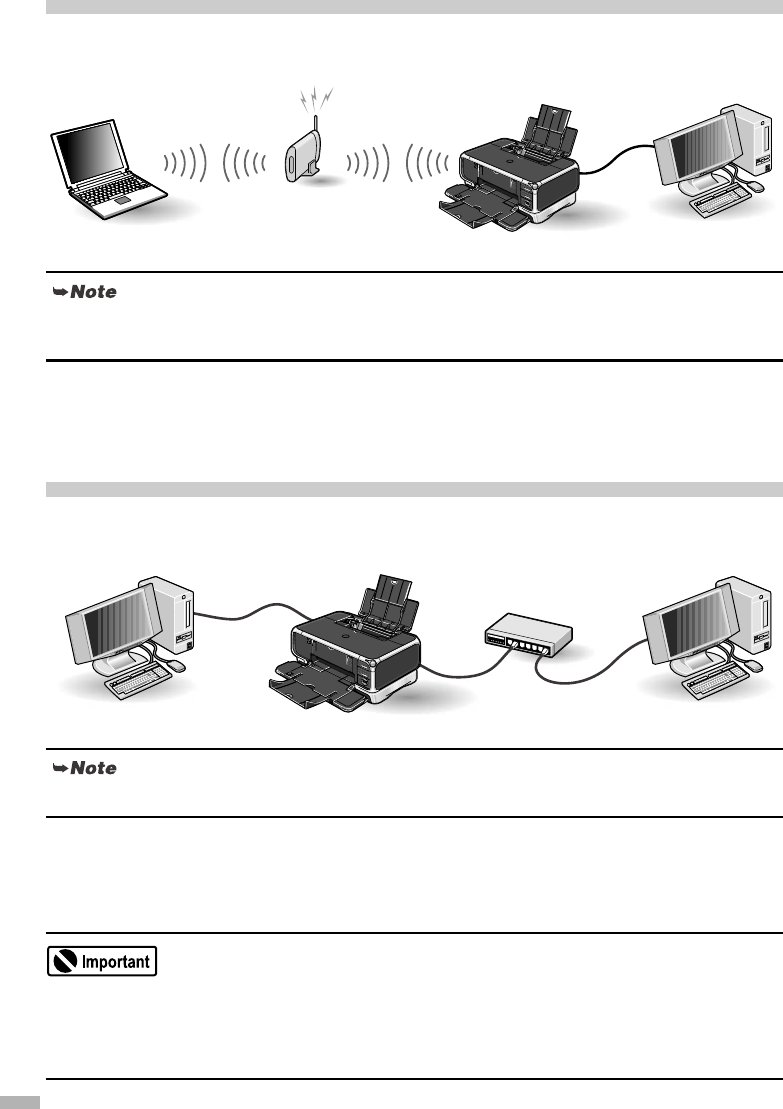
8
Using both USB Cable and Wireless LAN Connections
A computer communicates directly with the printer with a USB cable, while other computers are connected
over a wireless LAN (infrastructure mode).
You need to perform setup both on the computer to be used with USB connection and on the computers to be
used over wireless LAN.
To set up the printer in this configuration, see “First-time Setup for Use over Wireless LAN” on page 19 and
“Setting Up for Use with USB Connection” on page 39 after you finished setting the printer.
Using both USB Cable and Wired LAN Connections
A computer communicates directly with the printer with a USB cable, while other computers are connected
over wired LAN.
You need to perform setup both on the computer to be used with USB connection and on the computers to be
used over wired LAN.
To set up the printer in this configuration, see “First-time Setup for Use over Wired LAN” on page 31 and
“Setting Up for Use with USB Connection” on page 39 after you finished setting the printer.
A wireless LAN card or adapter must be installed in your computer to connect your computer to the
wireless LAN.
To connect over wired LAN, your computer needs to be connected to a hub or a similar network device.
To use this printer over wired and wireless LAN at the same time, the wired and wireless networks
need to be physically separate, and the printer needs to be assigned a different network address for
each network. Since this requires advanced network knowledge, we recommend that you do not use
the printer with wired and wireless LAN at the same time.
USB cable
Wireless LAN
access point
Wireless LAN Wireless LAN
Wired LAN
Hub
USB cable
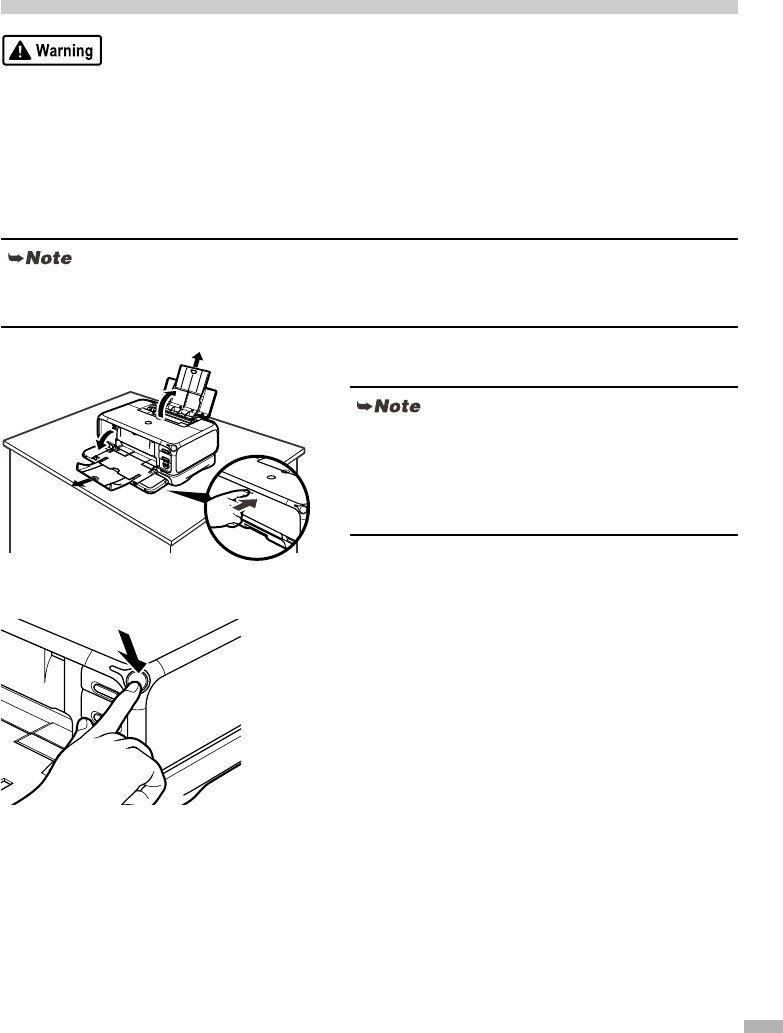
9
Setting Up
Installing the Print Head
• Never attempt to plug the power cord into the power outlet or unplug the power cord when your
hands are wet.
• Never damage, modify, stretch, or excessively bend or twist the power cord. Do not place heavy
objects on the power cord.
• Never use any power supply other than the standard power supply available in the country of
purchase. Using the incorrect voltage and frequency could cause a fire or electric shock.
• Always push the plug all the way into the power outlet.
1
Place the printer on a flat surface.
2
Plug the printer in.
3
Turn on the printer. Do NOT turn on the
computer yet.
The POWER lamp flashes and the printer begins to
operate. Wait until the POWER lamp remains fully lit.
If you do not intend to use the printer for a long period of time, unplug the power cord from the
power outlet after turning off the printer.
Even though wireless communication between
different rooms or floors is possible, the radio status
may become poor. Do not place the printer where its
communication with the access point may be
blocked.
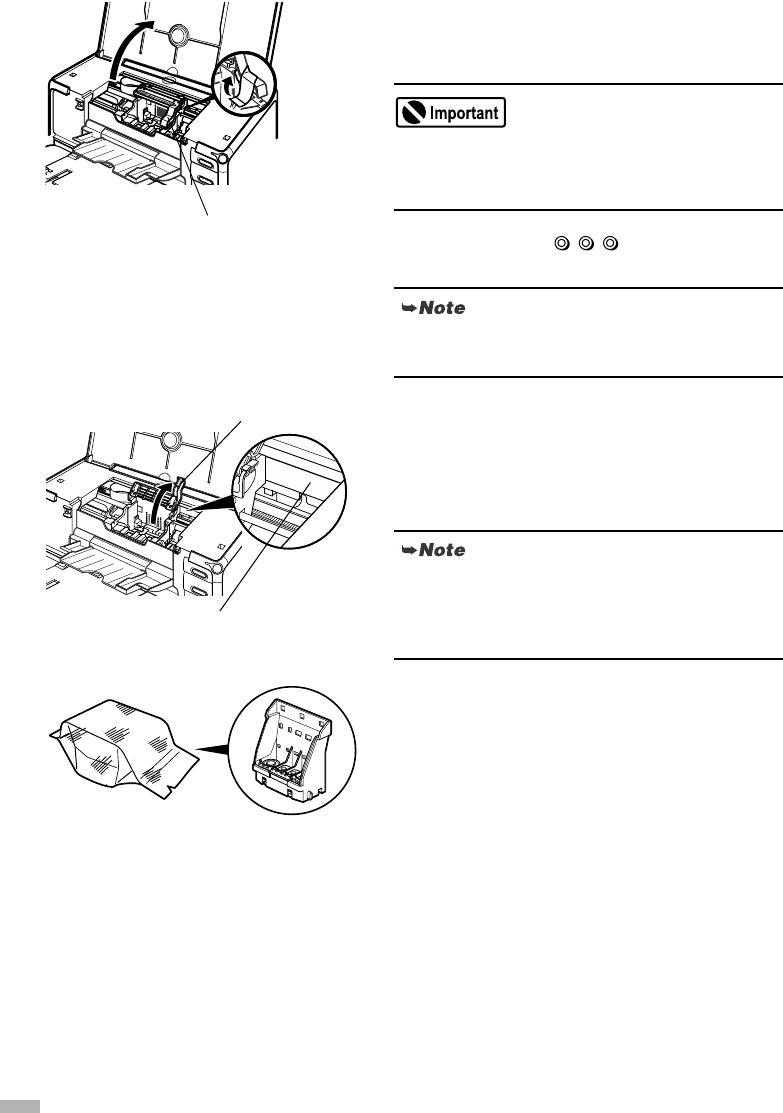
10
4
Open the Paper Output Tray and Top
Cover, and then pull down the Inner
Cover.
Push the upper center ( ) of the Front Cover to
open the Paper Output Tray.
5
Remove the tape.
6
Raise the Print Head Lock Lever.
Do not touch internal parts other than the Print Head
Lock Lever.
7
Remove the print head from its
package.
The Print Head Holder moves to the center when the
Top Cover is opened. Be careful not to touch it
while it is moving.
Support the Front Cover with your hand when
opening the tray.
For the customers in the United States
Write down the serial number located to the right of
the print head holder. You will need this later to
register the product.
Print Head Holder
Print Head Lock Lever
Serial number location
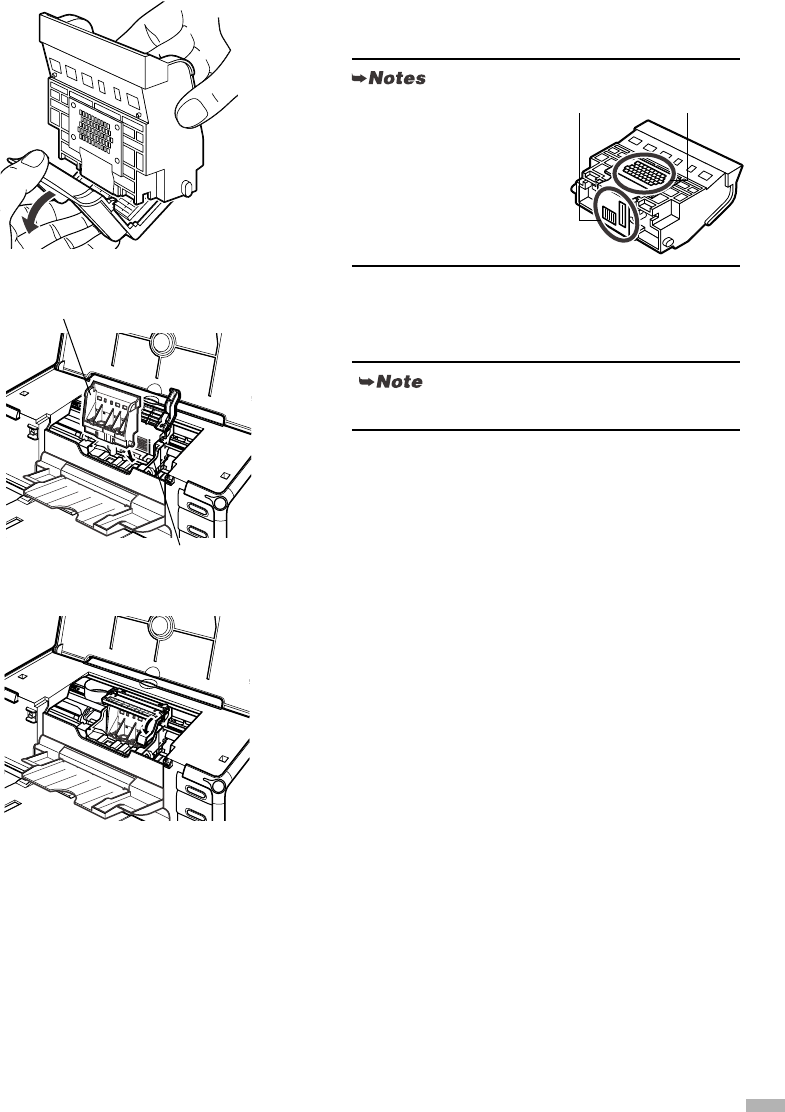
11
8
Remove the protective cap from the
Print Head.
9
Place the Print Head in the holder.
The print head will rest at a slight angle.
10
Lock the Print Head into place by
lowering the lever.
Do not touch the lever once the Print Head has been
installed.
• Do not touch the Print
Head Nozzles or
electrical contacts.
• Do not attempt to
reattach the protective
cap once it has been
removed.
Be careful not to touch any parts inside the printer.
electrical
contacts
Print Head
Nozzles
Print Head
Print Head Holder
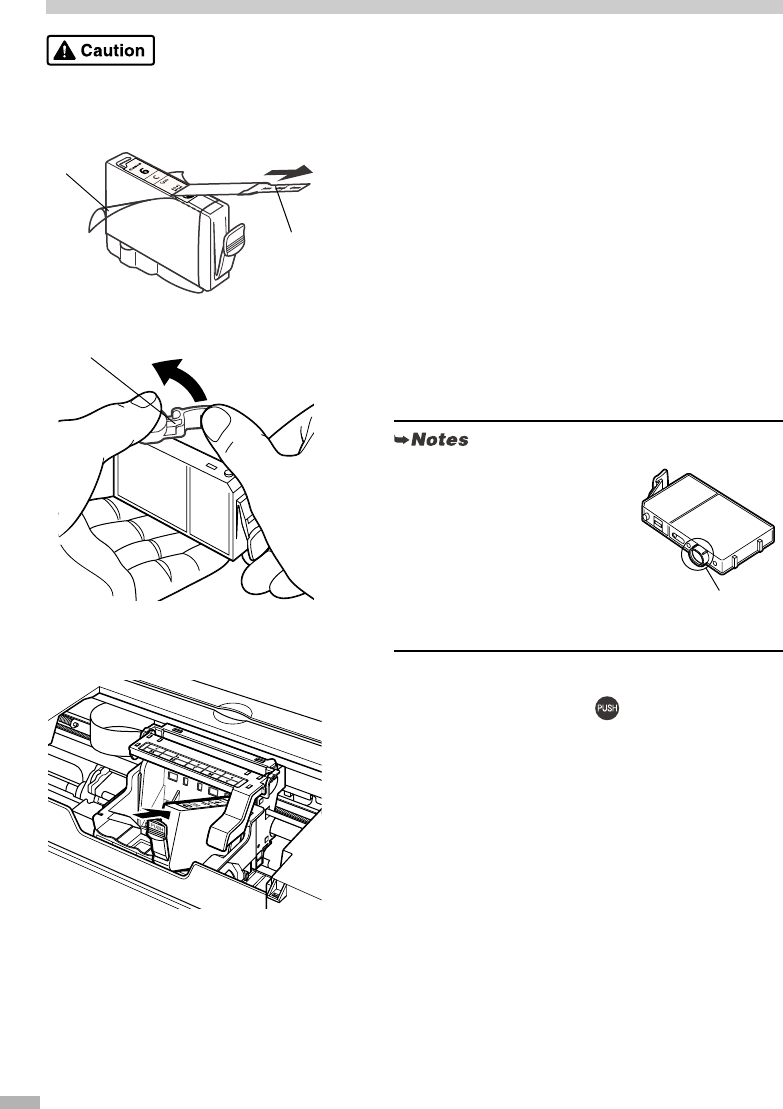
12
Installing the Ink Tanks
• For safety reasons, store ink tanks out of the reach of small children.
• Do not drop or shake ink tanks as this may cause the ink to leak out and stain your clothes and hands.
• Be sure to remove the clear film from the ink tank in the exact order as shown in step 2.
1
Unpack the cyan ink tank.
2
Pull the orange tape (A) off in the
direction of the arrow and remove the
clear film. Then, remove the film (B).
3
Hold the ink tank as shown in the
diagram and remove the orange
protective cap.
4
Insert the cyan ink tank into the right-
hand slot. Press the mark on the ink
tank until it clicks into place.
• Do not squeeze the side of
ink tanks as this may cause
the ink to leak out and stain
your clothes and hands.
• Do not touch the open ink
port.
• Do not reattach the protective
cap once you have removed
it.
(B)
(A)
Protective cap
ink port
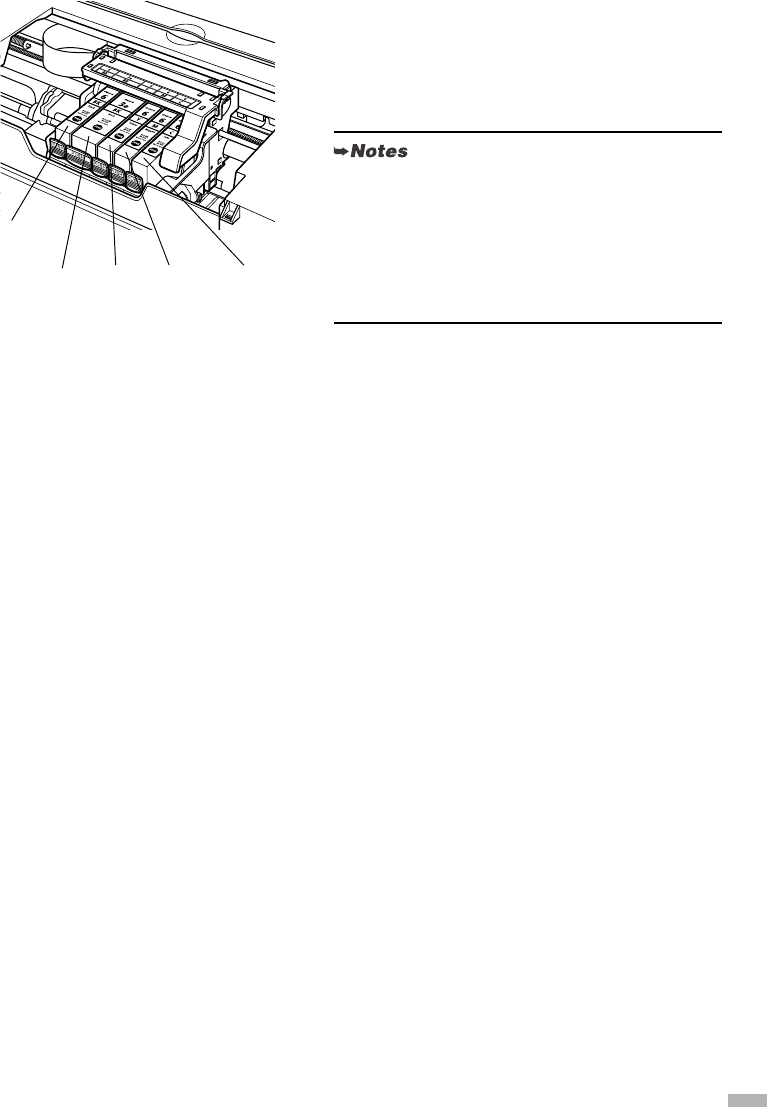
13
5
Use the same procedure to install the
other ink tanks into their appropriate
slots.
Check the labels to make sure that each tank is in the
correct position.
6
Put back the Inner Cover and close the
Top Cover.
• Only install the ink tanks in the positions specified
by the labels.
• If ink tanks are not installed in the right position,
colors will not be printed correctly. Immediately
reinstall the tank in the correct position and carry
out Print Head Cleaning. For details, refer to the
User’s Guide.
Yellow
BCI-6Y
Cyan
BCI-6C
Black
BCI-3eBK
Magenta
BCI-6M
Black
BCI-6BK
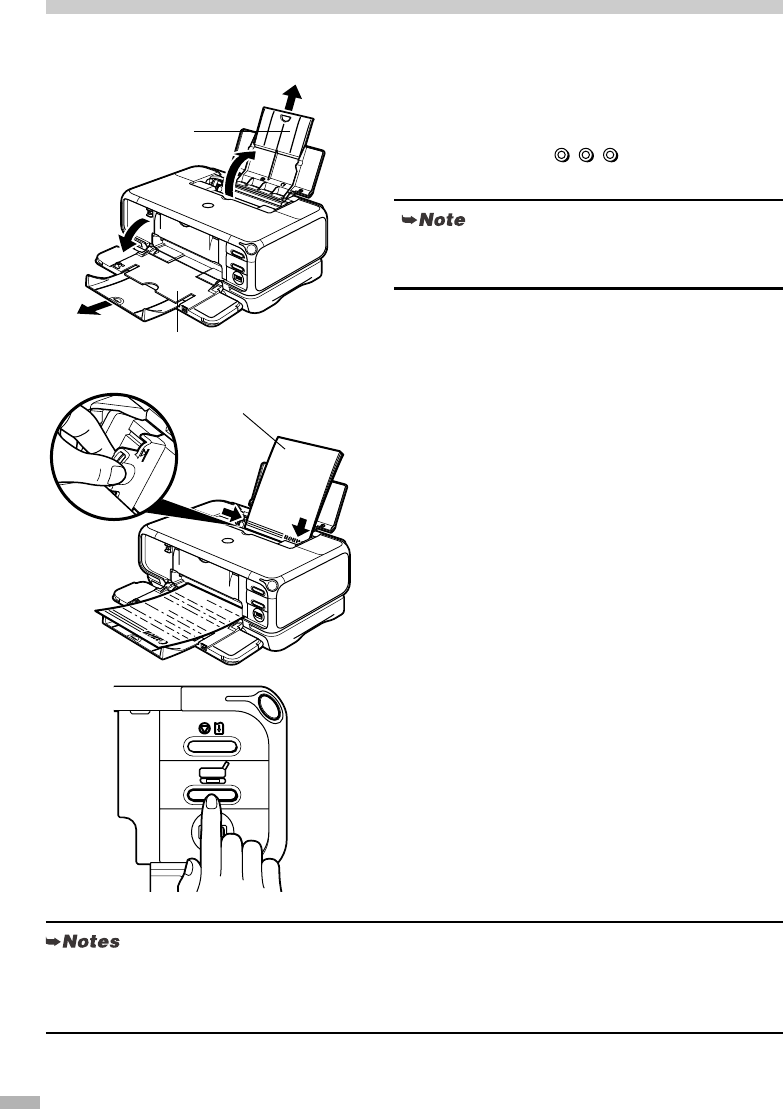
14
Loading Paper
This section describes how to load paper in the Sheet Feeder. When performing the print head alignment,
you need to load paper in the Sheet Feeder.
1
Pull out the Paper Support and Paper
Output Tray completely as shown.
Push the upper center ( ) of the Front Cover to
open the Paper Output Tray.
2
Load the paper and align it with the right
side of the Sheet Feeder.
You can load up to 150 sheets of plain paper (64 gsm/17
lb). Do not exceed this limit.
3
Slide the paper guide against the left
side of the paper stack.
4
Ensure that the Sheet Feeder lamp is lit.
If not, press the Paper Feed Switch.
Support the Paper Output Tray with your hand when
opening the tray.
Paper Output Tray
Paper Support
Print side
• Other than the Sheet Feeder, you can load paper in the Cassette. For information on loading the
print media in the Cassette, refer to the User's Guide.
• You can select the paper source also from the printer driver. For details, refer to the User's Guide.
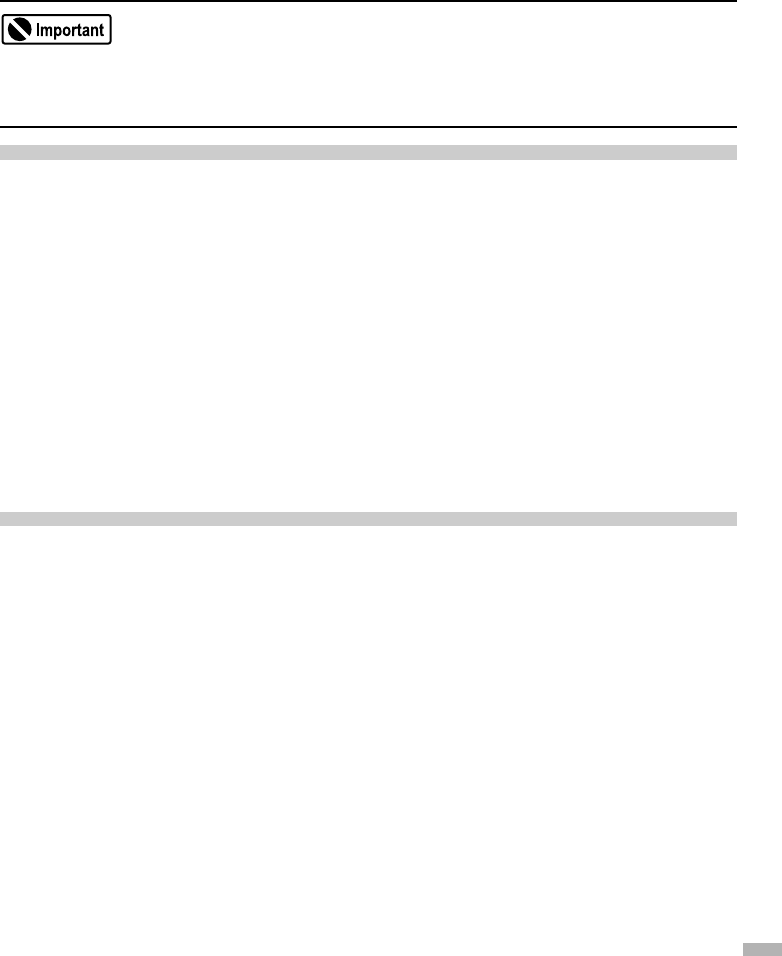
15
Confirming the Setup Procedure
Along with the various types of connection this printer is capable of (see “Confirming Your Connection
Type” on page 5), necessary setup procedure also differs with whether you are setting up the printer for the
first time or if the printer is already set up and you are adding new computers to use the printer.
Using the Printer for the First Time
When the printer is set up for the first time, the printer itself needs to be set up to be used over a
network, as well as the computer that uses it. Refer to the setup procedure for your connection
type.
• Connecting over Wireless LAN (Infrastructure Mode)
See “First-time Setup for Use over Wireless LAN - Windows” on page 19 or “First-time Setup for Use over
Wireless LAN - Macintosh” on page 25. Before setup, make sure that your computer’s connection with the
access point is operational.
• Connecting over Wired LAN
See “First-time Setup for Use over Wired LAN - Windows” on page 31 or “First-time Setup for Use over
Wired LAN - Macintosh” on page 35. Before setup, make sure that your computer’s connection via the
network is operational.
• Connecting with USB
See “Setting Up for Use with USB Connection - Windows” on page 39 or “Setting Up for Use with USB
Connection - Macintosh” on page 42.
Using the Printer Already Connected to a Network
If the printer is already set up to be shared over a network and you are adding a computer to use it,
the new computer needs to be set up but the printer itself does not need to be set up again.
See“Setting Up an Additional Computer to Use a Printer Already Connected to a Network -
Windows” on page 45 or “Setting Up an Additional Computer to Use a Printer Already Connected
to a Network - Macintosh” on page 48. Before setup, make sure that your computer’s connection
with the network is operational.
• Before proceeding to setup, make sure to read and follow directions in “Before Setup” on page 16.
• If you are using wireless LAN, see “Confirming Settings of your Access Point” on page 18 and
make a note of the access point settings.
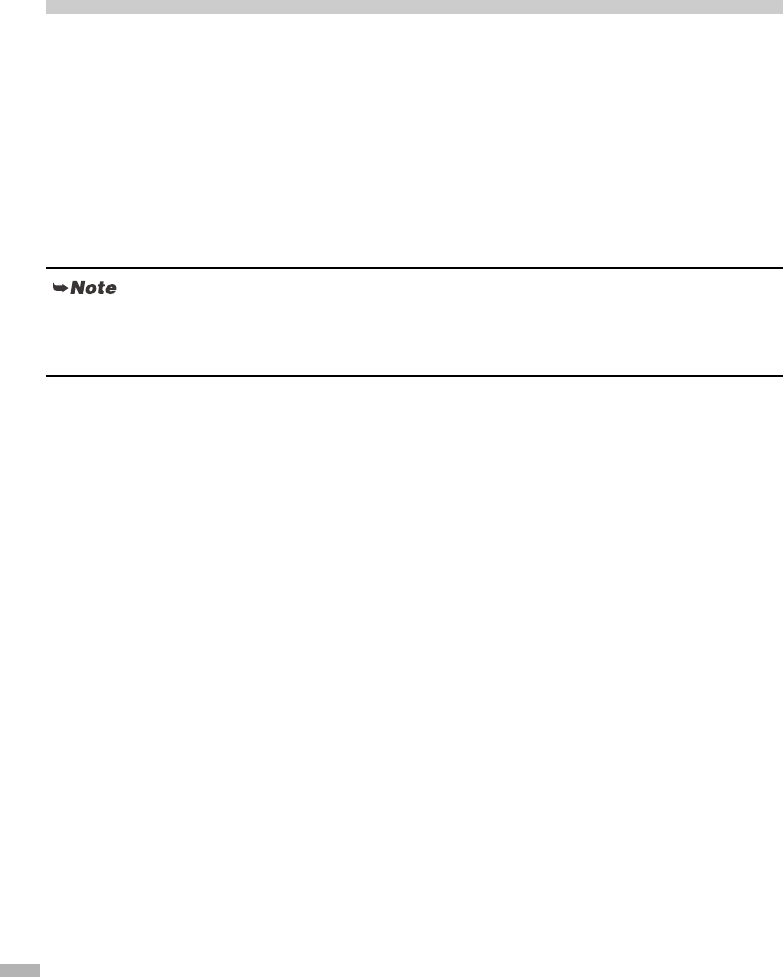
16
Setting Up the Printer and
the Computer
Before Setup
Make sure of the following before proceeding to installation.
• Disable virus detection or any other resident programs.
• Make sure you are connected to the Internet through your LAN. To confirm this, see if you can browse the
web.
• If MAC address filtering or IP address filtering is set to the access point or the router to connect to, disable
it.
• To find out the MAC address of your printer, print the network settings information. To print the network
setting information, see “Printing and Initializing Network Settings” on page 67.
• If you connect to a network that is not protected with security measures, there is a risk of disclosing data
such as your personal information to a third party.
• Disable the firewall of any security software until the setup is complete. For details on firewalls, see “On
Firewalls” on page 17.
• If you are using wireless LAN connection, make sure that the computer and the access point is set up
properly and wireless communication is possible.
• If you are using wireless LAN connection, make sure you know the name of the network you are using
(SSID).
• If you are using wireless LAN connection, and a WEP key or a WPA key is set to the access point, make
sure you know the WEP or the WPA key.
• If you are using wired LAN, make sure that your computer and network devices such as hubs are set up
properly so that communication is possible through the wired LAN.
• When the printer is already shared over a network and you are adding a computer to use it, disable the
printer’s access control features if it is enabled.
For details on the SSID, WEP key, WPA key, MAC address filtering, or IP address filtering of the access
point, refer to its manual. See “Confirming Settings of your Access Point” on page 18 and make a note of
the access point settings.
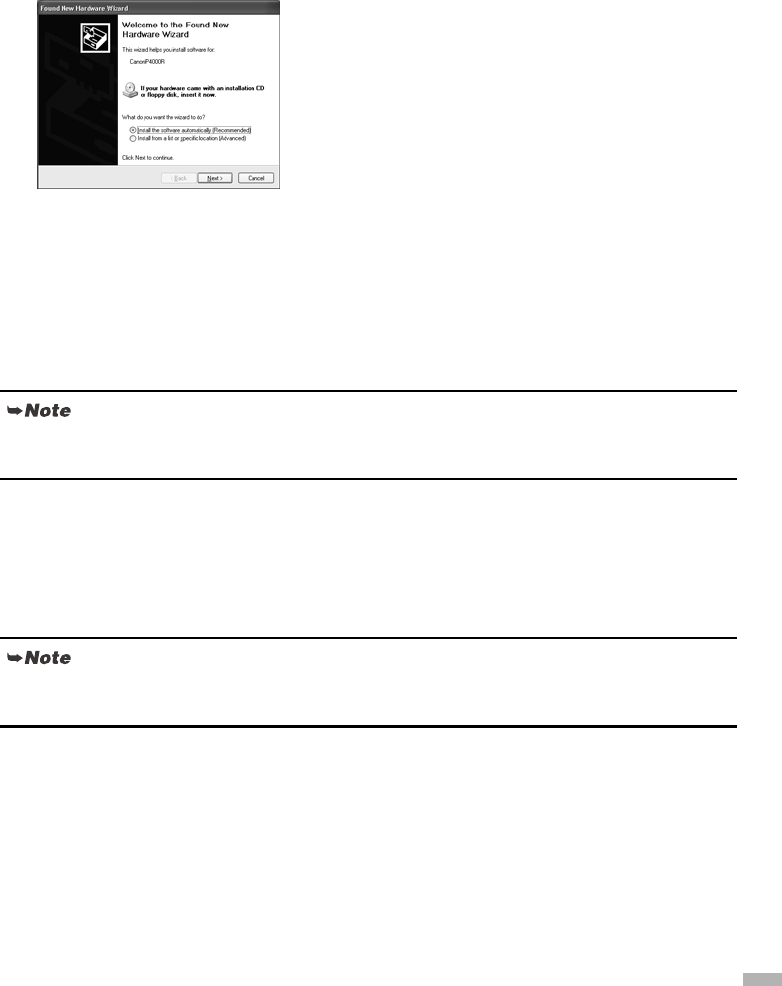
17
For Windows
• When using Windows XP, you must log on as the administrator. When using Windows 2000, you must
log on as a member of the administrators group. Do not switch users during setup.
• If the following screen appears automatically, click
Cancel
to quit the screen, turn off the printer, remove
the USB cable, then resume setup. Re-insert the
Setup Software & User’s Guide
CD-ROM.
If you are using Windows XP Service Pack 1 or earlier and you have Internet Connection Firewall
enabled, a dialog box asking you for confirmation to disable the firewall will appear during setup.
Click Ye s to disable the firewall. When setup is complete, the firewall will be re-enabled
automatically.
To confirm the version of your Windows XP, see “Confirming the version of Windows XP” on
page 82.
For details on firewalls, see “On Firewalls” on page 17.
On Firewalls
A firewall is a system that prevents unauthorized access to a local network from the outside.
However, a firewall may prevent proper setup or wireless communication of the printer. When
setting up the printer for a use over a network, disable the firewall of your security software.
Some programs, such as network configuration software, may automatically enable Internet Connection
Firewall. Check settings of any such program.
For information on the firewall feature of your security software, refer to its manual. In an office setup,
consult your network administrator.
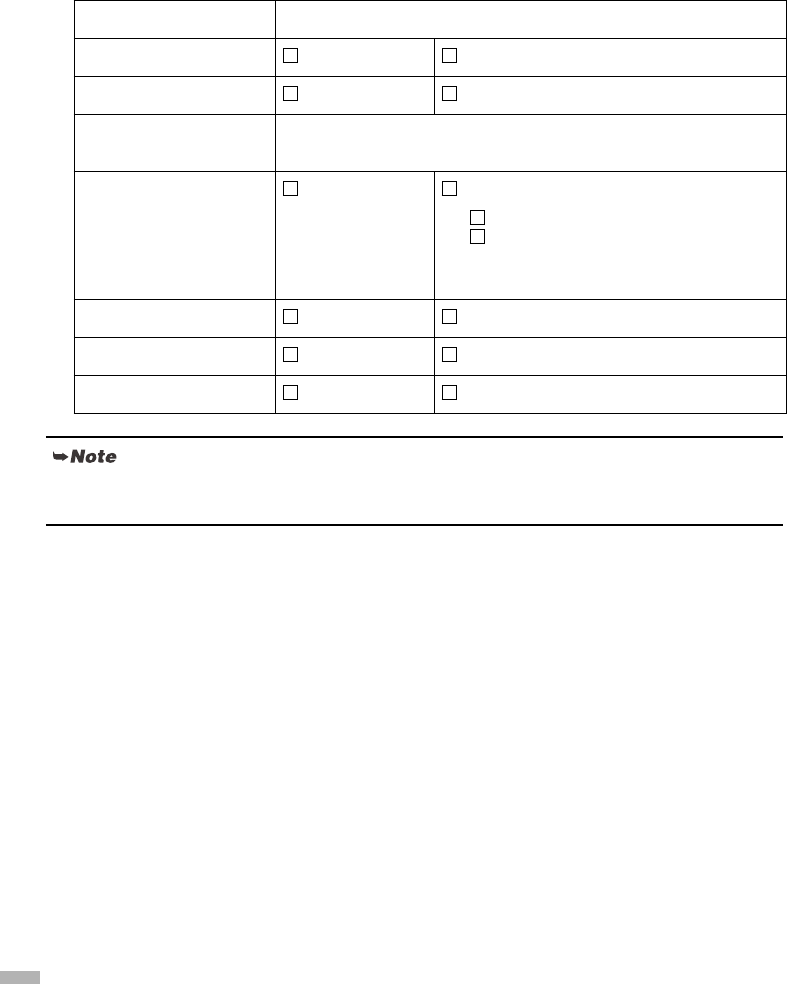
18
Confirming Settings of your Access Point
When setting up the printer to be used over wireless LAN, the printer’s network settings are
configured to match those of the access point. Therefore, if you are using wireless LAN, we
recommend that you confirm the necessary information on the access point before entering the
setup process. Check and fill in the table below.
• If Stealth (closed network) or ANY-Rejection feature is enabled
We recommend you to disable it before entering setup.
• If MAC address filtering is enabled
We recommend that you register the printer’s MAC address to the access point before entering setup. To
confirm the MAC address of the printer, print the printer’s network information. See “Printing Network
Setting Information” on page 67.
• If IP address filtering is enabled
Disable the access point’s IP address filtering feature before entering setup.
• If Client-to-Client Blocking is enabled
An access point may be capable of blocking all direct transmission among clients associated to it. If such
feature is enabled, disable this feature before entering setup.
SSID/network name
Stealth/closed network Disabled Enabled
ANY-Rejection Disabled Enabled
Radio channel Channel ( )
The printer can communicate in channels 1 to 11.
Encryption Disabled Enabled
WEP: key ( )
WPA: key ( )
This printer supports only the PSK-TKIP
authentication type.
MAC address filtering Disabled Enabled
IP address filtering Disabled Enabled
Client-to-Client Blocking Disabled Enabled
For information on how to confirm the settings of the access point, refer to the manual provided with the
access point.
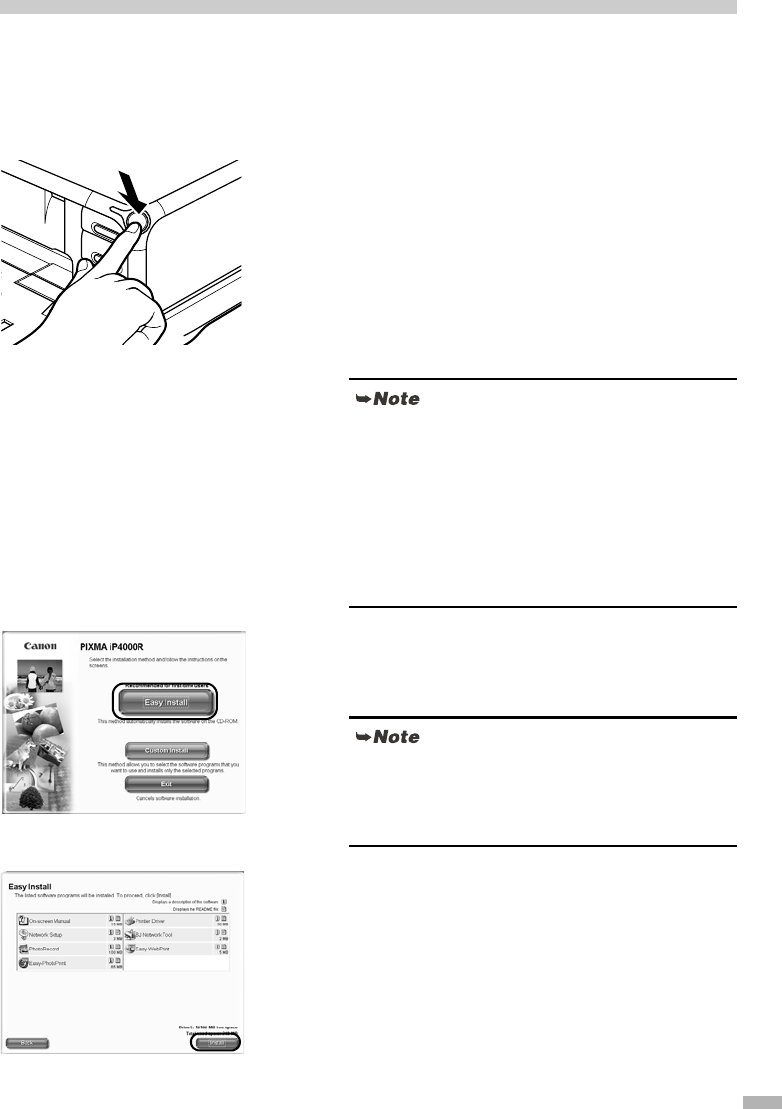
19
First-time Setup for Use over Wireless LAN
When you are setting up the printer to be used over wireless LAN (infrastructure mode) for the first time, the
printer is set up to be used over a network, as well as the computer that uses it. Follow these steps.
First-time Setup for Use over Wireless LAN - Windows
1
Ensure that the printer and the
computer are turned off.
2
Turn on the computer and start
Windows. If any applications
automatically run, quit them.
Do NOT turn the printer on at this stage.
3
Place the Setup Software & User’s
Guide CD-ROM in the CD-ROM drive.
4
Follow the instructions displayed on
screen. When the screen shown on the
left is displayed, click Easy Install.
5
When the list of applications to install
appears, verify the contents, click
Install, then follow the instructions on
the screen.
• If the CD-ROM does not run automatically, click
Start and select My Computer, then double-click
the CD-ROM icon. For non-XP Windows, double-
click My Computer in the Windows screen, then
double-click the CD-ROM icon.
• If the language selection screen appears, select the
language, then click OK.
• If the location selection message appears, select
your place of residence, then click Next.
When you select
Easy Install
, the items included in the
CD-ROM are installed automatically. To select
particular items to install, click
Custom Install
and
follow the instruction on the screen.
OFF

20
6
Read the License Agreement carefully
and click Yes.
7
Select Set up the printer and the
computer and click Next.
8
When the screen shown on the left
appears, connect the printer with a USB
cable.
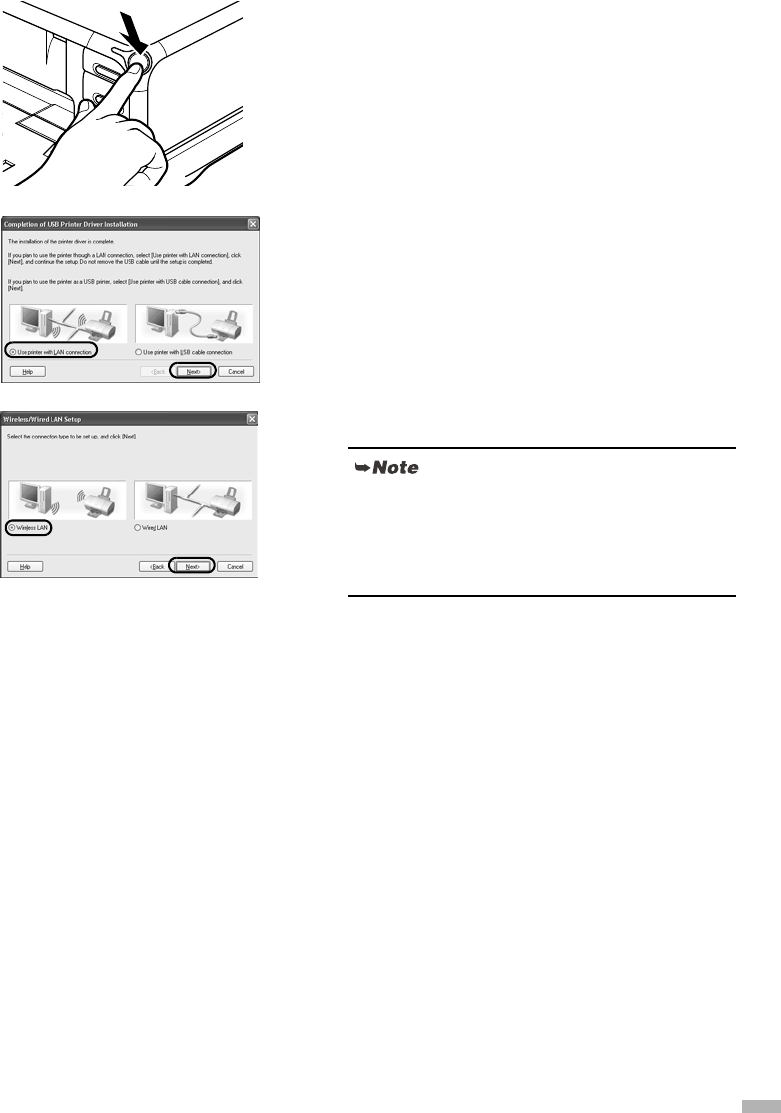
21
9
Turn on the printer.
If the printer is recognized, the next screen will appear
automatically. If the connection is not recognized, click
Help
and follow its instructions.
10
Select Use printer with LAN
connection and click Next.
11
Select Wireless LAN and click Next.
If the printer’s network settings have been set before,
the
Printer Network Setup
dialog box is displayed.
For details, see “The Printer Network Setup dialog box
is displayed during setup” in “Troubleshooting” on
page 79.
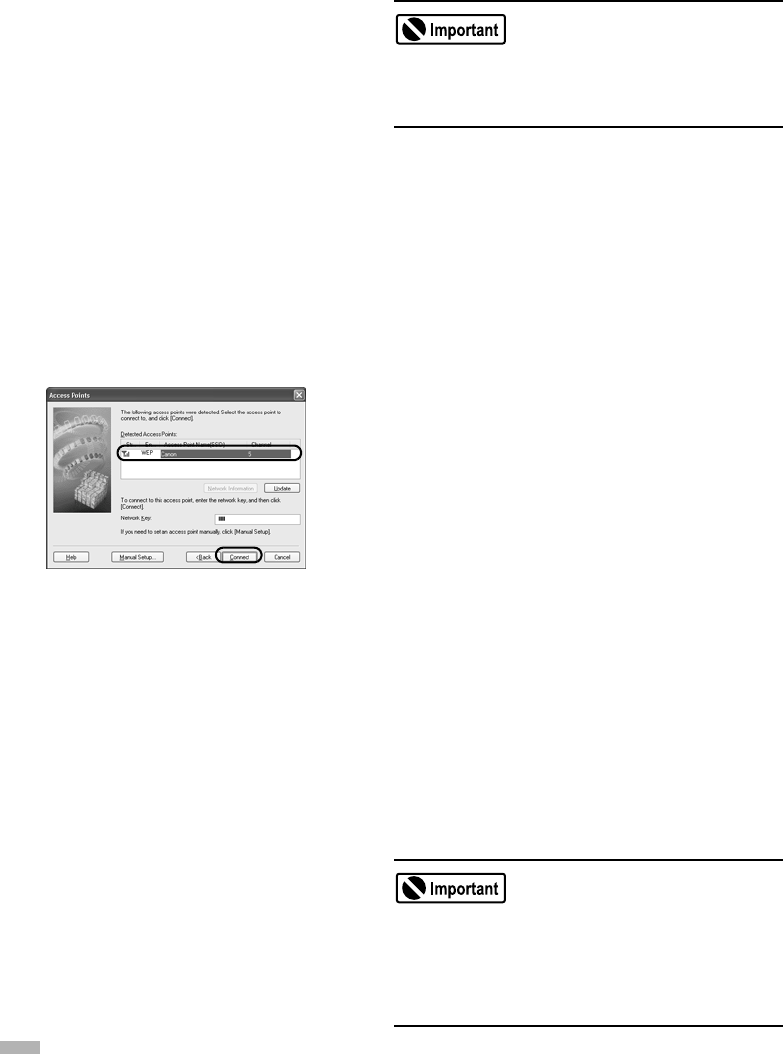
22
12
Setup automatically detects your
access point.
An access point is detected automatically and setup
proceeds to the next step when
• Setup detects an access point with the same SSID
as the access point currently connected to your
computer, and the access point is not using
encryption.
• Setup did not detect an access point with the same
SSID as the access point currently connected to
your computer (or your computer is currently not
connected to an access point in the first place), but
a single access point without encryption was
detected.
If the detected access point is using encryption
When setup detects an access point with the same SSID
as the access point currently connected to your computer,
and the access point is using encryption (WEP or WPA),
the
Access Points
dialog box is displayed with the
access point highlighted in the list.
Enter the network key (WEP key or WPA key) set to the
access point and click
Connect
.
If multiple access points were detected
If setup did not detect an access point with the same
SSID as the access point currently connected to your
computer (or your computer is currently not connected to
an access point in the first place), and two or more access
points were detected, the
Access Points
dialog box is
displayed.
Select your target access point and click
Connect
.
If
WEP
or
WPA
is displayed in the
Encryption
column,
a network key (WEP or WPA key) is set to your access
point. Enter the network key (WEP key or WPA key) set
to the access point and click
Connect
.
If you connect to a network that is not protected with
security measures, there is a risk of disclosing data
such as your personal information to a third party.
You cannot connect to an access point using WPA-
802.1x or an access point using WPA-PSK with type of
dynamic encryption set to AES. See “The Access
Points dialog box is displayed during setup” on
page 72.

23
If no access points were detected, or your target access
point is not displayed
If the
An access point could not be detected
message
appears, click
OK
to display the
Access Points
dialog
box. Click
Update
to perform detection again. If your
access point is still not listed, take the following
measures.
• Ensure that the access point is on and then click
Update.
• Ensure that the printer is on and connected to your
computer with a USB cable, then click Update.
• Move your printer closer to the access point and
remove possible obstructions, then click Update.
• If all above fails, use manual searching. For details,
see “The target access point is not detected, or you
want to specify access point settings manually” in
“Troubleshooting” on page 74.
• Using your access point’s utility software, check if
your access point is set to the stealth mode, i.e., set
not to broadcast its SSID, or is set to reject clients
whose SSID is set to ANY. If so, click Manual
Setup and enter the access point’s SSID in SSID.
• If the Encryption column is blank, the access
point is not encrypted.
• For details, see “The Access Points dialog box is
displayed during setup” in “Troubleshooting” on
page 72.
• For details on the access point’s SSID and
network key (WEP key or WPA key) setting, refer
to the manual provided with the access point.
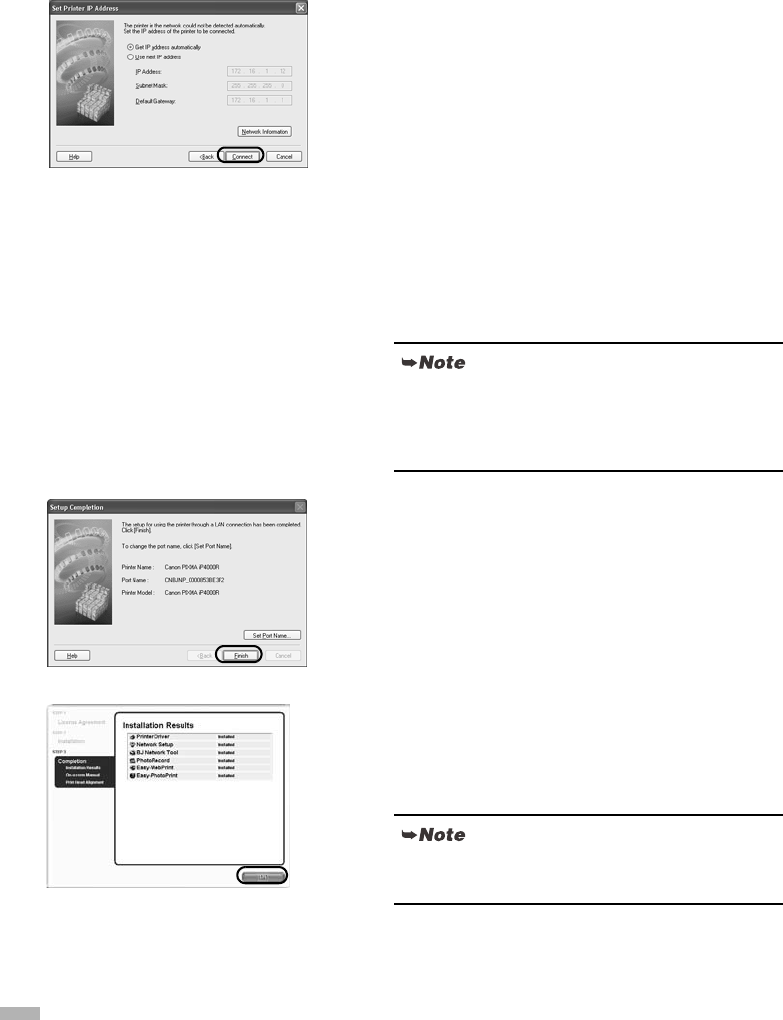
24
13
Setup automatically detects the printer.
The iP4000R connected with a USB cable is detected
automatically.
If the printer was not detected, the
Set Printer IP
Address
dialog box appears. Click
Connect
to retry
detection. If the printer is still not detected, take the
following measures.
• Ensure that the printer is on and connected to your
computer with a USB cable, then click Connect.
• Move your printer closer to the access point and
remove possible obstructions, then click Connect.
• Ensure that the computer’s connection with the
access point is operational, then click Connect.
• If all above fails, use manual searching. To confirm
the IP address, click Network Information in the
Set Printer IP Address dialog box. For details, see
“The Set Printer IP Address / Printer IP Address
Setup dialog box is displayed during setup” in
“Troubleshooting” on page 77.
14
Remove the USB cable, and click
Finish.
To change the port name, click
Set Port Name
. For
details, see “Changing the port name” in
“Troubleshooting” on page 81.
Setup will next install application programs.
15
When the installation results are
displayed, click OK.
If you are prompted to restart the computer, click
Yes
and restart the computer.
Be sure to re-connect the printer to your computer with
a USB cable when changing the wireless LAN setting.
Otherwise, your computer may fail to communicate
with the printer.
If the online registration dialog box appears, follow the
on-screen instructions to register your product.
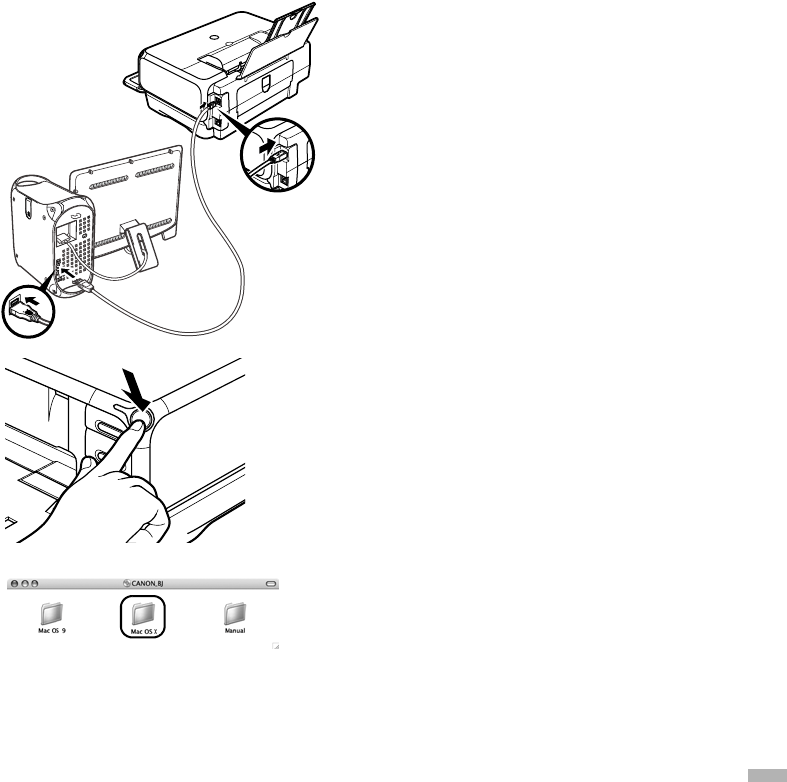
25
16
When the On-Screen Manual dialog
box appears, click Next.
Printer software installation is now complete. Setup next
proceeds to perform print head alignment.
17
When the Print Head Alignment dialog
box appears, confirm that a sheet of A4
or Letter-sized plain paper is loaded in
the Sheet Feeder, and click Execute.
Go to step 5 of “Aligning the Print Head - Windows” on
page 52.
First-time Setup for Use over Wireless LAN - Macintosh
1
Connect the printer with a USB cable.
2
Turn on the printer.
3
Turn on the Mac.
4
Place the Setup Software & User’s
Guide CD-ROM in the CD-ROM drive.
5
Double-click the Mac OS X folder, then
double-click the Printer Driver folder.
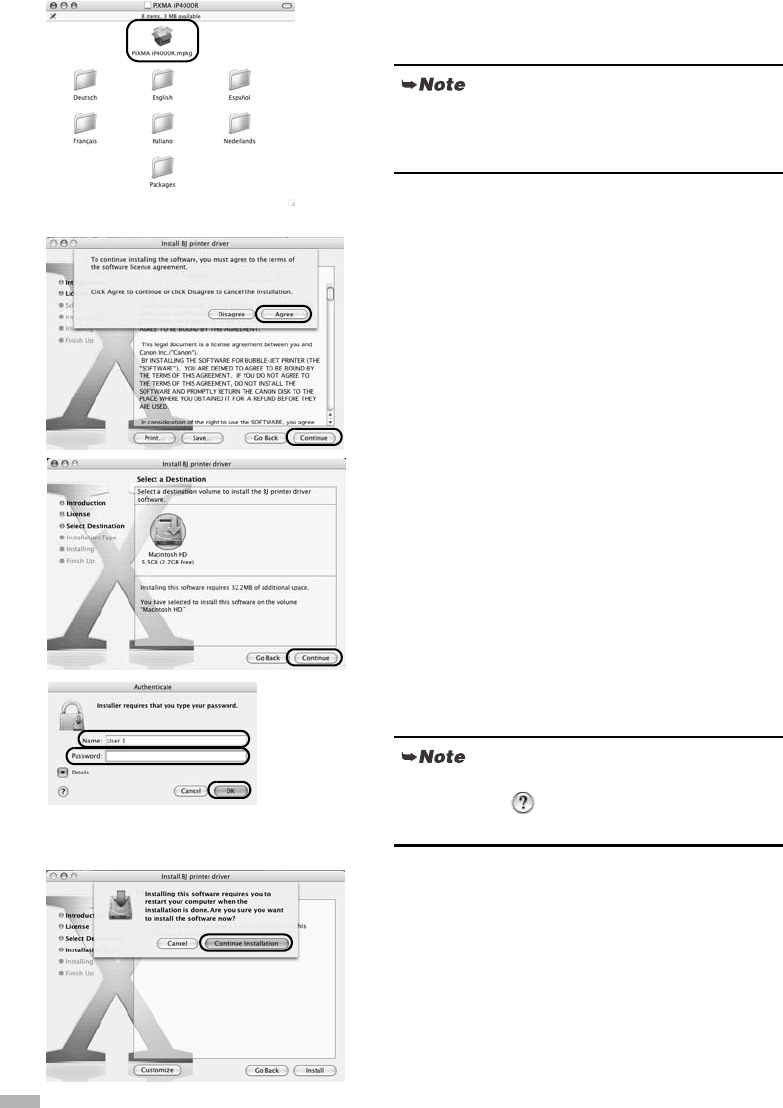
26
6
Double-click PIXMA iP4000R xxx.pkg.
“x” represents a number.
7
Click Continue.
8
Read the License Agreement carefully
and click Continue, then click Agree.
9
Select a destination to where you want
to install the printer driver, and click
Continue.
10
Click Install.
When using Mac OS X v.10.2, go to step 12.
11
Enter the administrator’s name and
password, and click OK.
12
A message asking for your confirmation
to restart your Mac appears on the
screen. Read the message, then click
Continue Installation.
Software installation will start.
When using Mac OS X v.10.2, the
Authenticate
dialog
box appears. Enter the administrator’s name and
password, and click
OK
.
If you have forgotten the administrator name and/or
password, click and follow the instructions in
Mac
Help
.
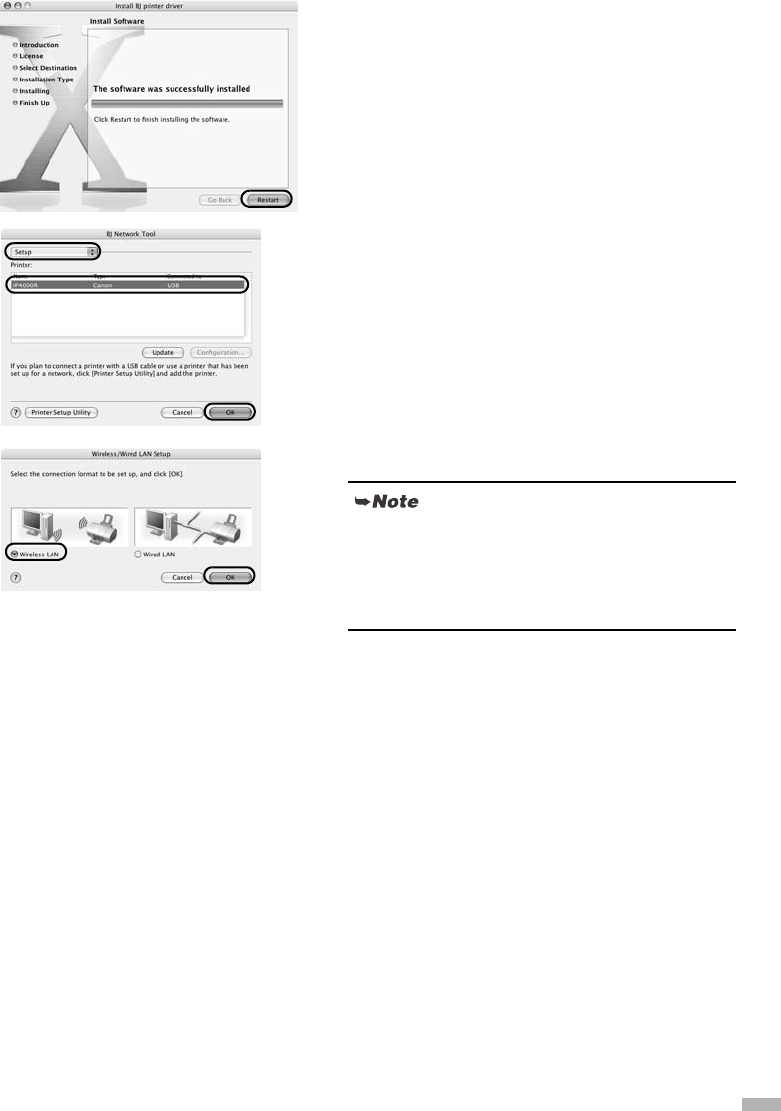
27
13
Click Restart.
When the computer restarts, BJ Network Tool will start
up. If it does not start automatically, select
Library
-
Printers
-
Canon
-
BJ Printer
-
Utilities
-
BJ Network
Tool
.
14
Select Setup from the pop-up menu
and iP4000R in Printer, then click OK.
If the
The printer could not be detected
message is
displayed, check that your printer is connected with a
USB cable and turned on, then click
Update
.
15
Select Wireless LAN and click OK.
If the printer’s network settings have been set
before, the Printer Network Setup dialog box is
displayed. For details, see “The Printer Network
Setup dialog box is displayed during setup” in
“Troubleshooting” on page 79.
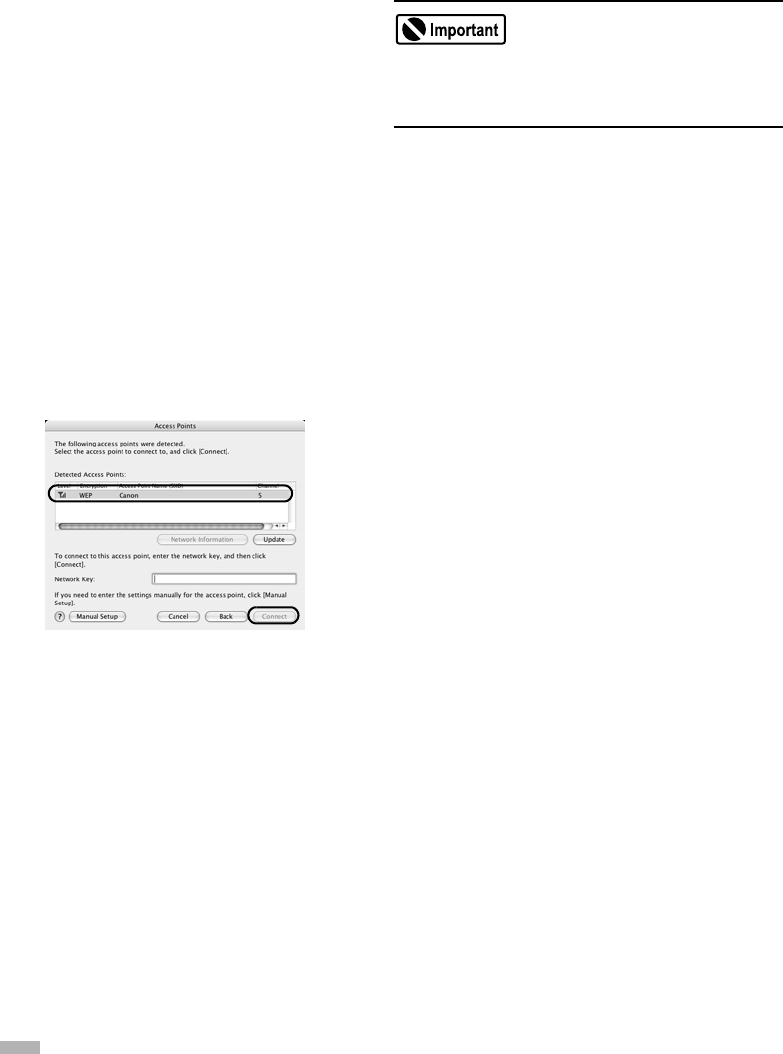
28
16
Setup automatically detects your
access point.
An access point is detected automatically and setup
proceeds to the next step when
• Setup detects an access point with the same
network name (SSID) as the access point currently
connected to your computer (when using AirPort
Admin Utility version 3.1 or later), and the access
point is not using encryption.
• Setup did not detect an access point with the same
network name (SSID) as the access point currently
connected to your computer (or your computer is
currently not connected to an access point in the
first place), but a single access point without
encryption was detected.
If the detected access point is using encryption
When setup detects an access point with the same
network name (SSID) as the access point currently
connected to your computer, and the access point is
using encryption (Password (WEP key) or WPA), the
Access Points
dialog box is displayed with the access
point highlighted in the list.
Enter the network key (Password (WEP key) or WPA
key) set to the access point and click
Connect
.
If multiple access points were detected
If setup did not detect an access point with the same
network name (SSID) as the access point currently
connected to your computer (or your computer is
currently not connected to an access point in the first
place), and two or more access points were detected, the
Access Points
dialog box is displayed.
Select your target access point and click
Connect.
If
WEP
or
WPA
is displayed in the
Encryption
column,
a network key (Password (WEP key) or WPA key) is set
to your access point. Enter the network key (Password
(WEP key) or WPA key) set to the access point and click
Connect
.
If you connect to a network that is not protected with
security measures, there is a risk of disclosing data
such as your personal information to a third party.
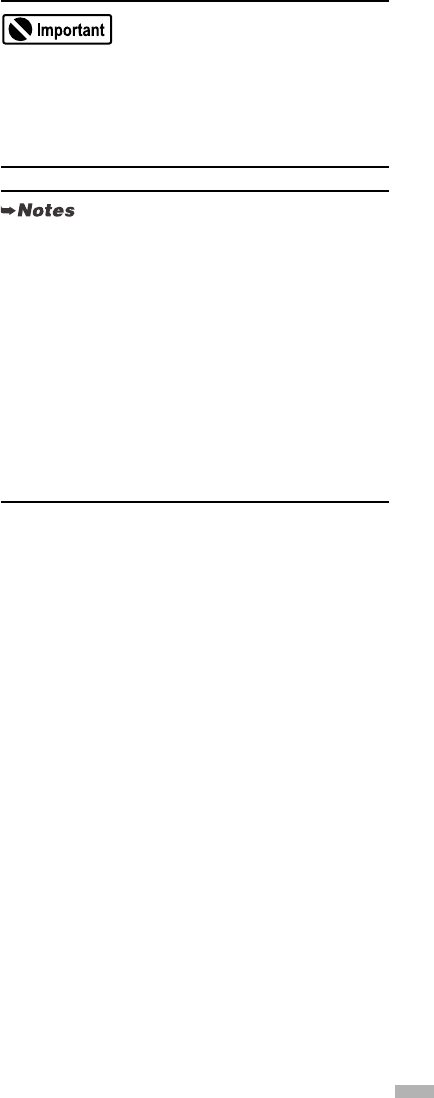
29
If no access points were detected, or your target access
point is not displayed
If the
An access point could not be detected
message
appears, click
OK
to display the
Access Points
dialog
box. Click
Update
to perform detection again. If your
access point is still not listed, take the following
measures.
• Ensure that the access point is on and then click
Update.
• Ensure that the printer is on and connected to your
computer with a USB cable, then click Update.
• Move your printer closer to the access point and
remove possible obstructions, then click Update.
• If all above fails, use manual searching. For details,
see “The target access point is not detected, or you
want to specify access point settings manually” in
“Troubleshooting” on page 74.
• Using your access point’s utility software, check if
your access point is set to a closed network / stealth
mode. If so, click Manual Setup and enter the
access point’s network name (SSID) in Network
(SSID).
You cannot connect to an access point using WPA
Enterprise or an access point using WPA Personal
with type of dynamic encryption set to AES. See
“The Access Points dialog box is displayed during
setup” on page 72.
• If the Encryption column is blank, the access
point is not encrypted.
• For details, see “The Access Points dialog box is
displayed during setup” in “Troubleshooting” on
page 72.
To confirm the password (WEP key) or the WPA
key when using AirPort Base Station, use the
AirPort Admin Utility. For details, refer to its
online help.
• For details on the access point’s network name
(SSID) and network key (WEP key or WPA key)
setting, refer to the manual provided with the
access point.
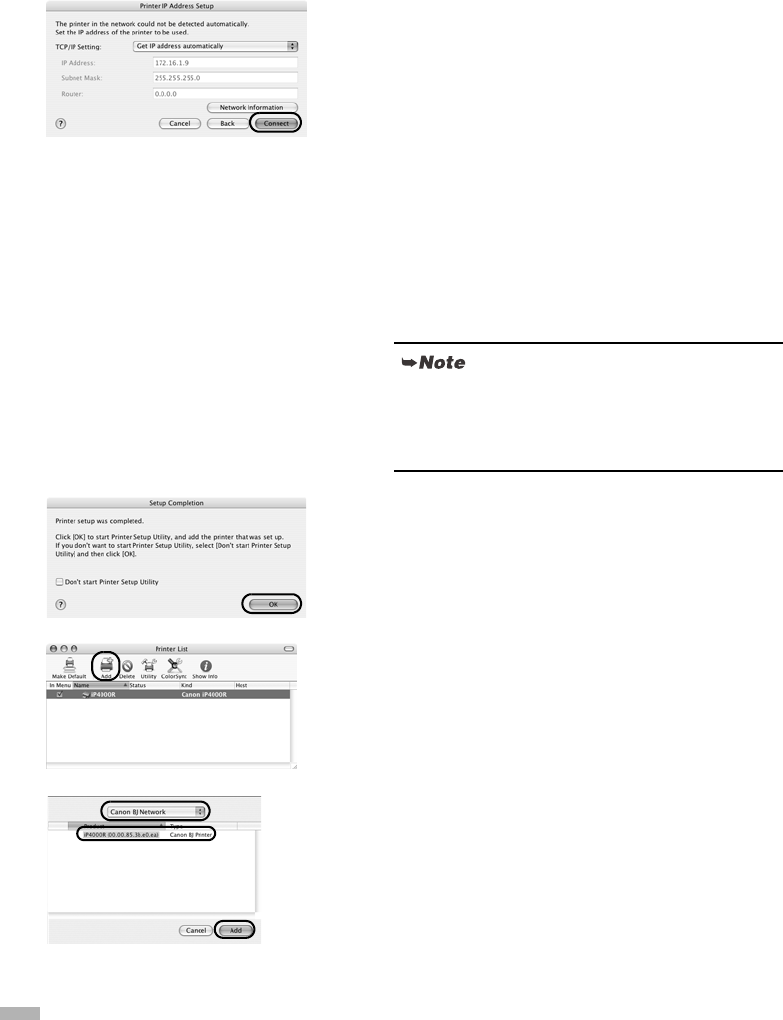
30
17
Setup automatically detects the printer.
The iP4000R connected with a USB cable is detected
automatically.
If the printer was not detected, the
Printer IP Address
Setup
dialog box appears. Click
Connect
to retry
detection. If your printer is still not detected, take the
following measures.
• Ensure that the printer is on and connected to your
computer with a USB cable, then click Connect.
• Move your printer closer to the access point and
remove possible obstructions, then click Connect.
• Ensure that the computer’s connection with the
access point is operational, then click Connect.
• If all above fails, use manual searching. To confirm
the IP address, click Network Information in the
Set Printer IP Address dialog box. For details, see
“The Set Printer IP Address / Printer IP Address
Setup dialog box is displayed during setup” in
“Troubleshooting” on page 77.
18
Remove the USB cable and click OK.
The Printer Setup Utility (Print Center on Mac OS X
v.10.2) will start up.
19
Click Add.
20
Select CANON BJ Network from the
pop-up menu, select iP4000R from the
list of printers, and click Add.
The alphanumeric string after the printer name is its
MAC address.
Be sure to re-connect the printer to your computer
with a USB cable when changing the wireless LAN
setting. Otherwise, your computer may fail to
communicate with the printer.
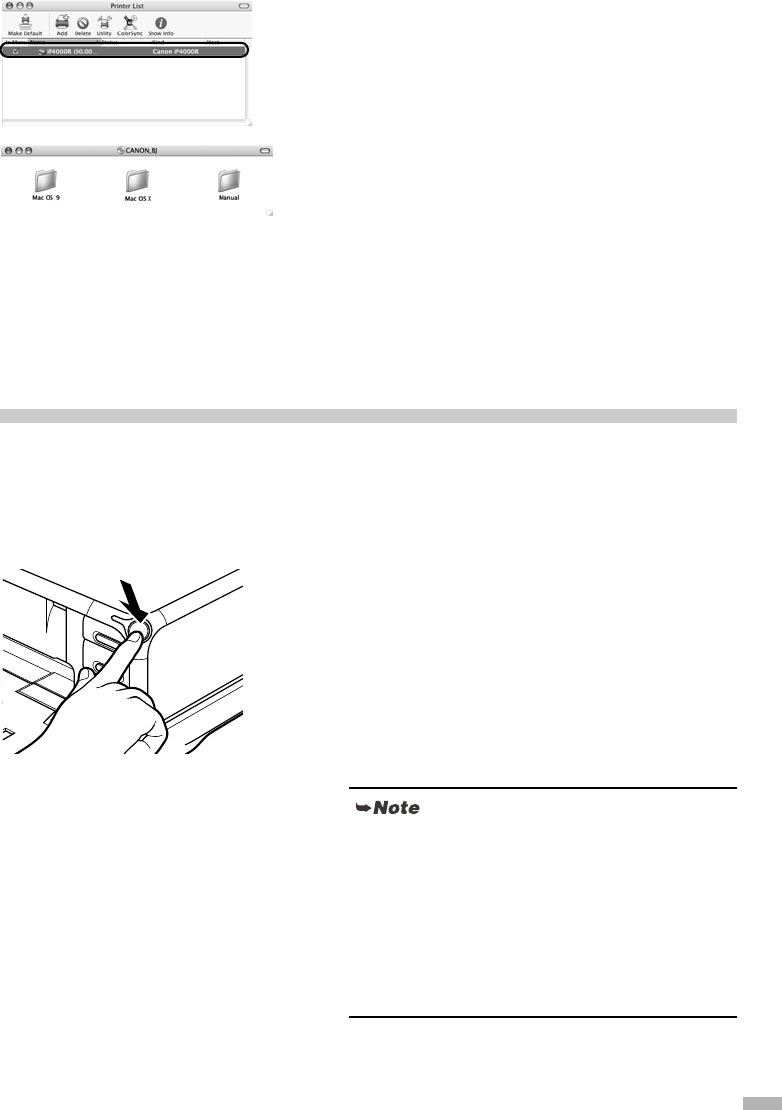
31
21
Confirm that your printer is added to the
list of printers.
Printer driver setup is now complete.
22
Install applications. In the Setup
Software & User’s Guide CD-ROM,
double-click CANON_BJ and then
double-click Application.
Double-click the installer in folder for each application
you want to install.
23
Perform print head alignment before
you start using your printer.
See “Aligning the Print Head - Macintosh” on page 53.
First-time Setup for Use over Wired LAN
When you are setting up the printer to be used over wired LAN for the first time, the printer is set up to be
used over a network, as well as the computer that uses it. Follow these steps.
First-time Setup for Use over Wired LAN - Windows
1
Ensure that the printer and the
computer are turned off.
2
Turn on the computer and start
Windows. If any applications
automatically run, quit them.
Do NOT turn the printer on at this stage.
3
Place the Setup Software & User’s
Guide CD-ROM in the CD-ROM drive.
• If the CD-ROM does not run automatically, click
Start and select My Computer, then double-click
the CD-ROM icon. For non-XP Windows, double-
click My Computer in the Windows screen, then
double-click the CD-ROM icon.
• If the language selection screen appears, select the
language, then click OK.
• If the location selection message appears, select
your place of residence, then click Next.
OFF
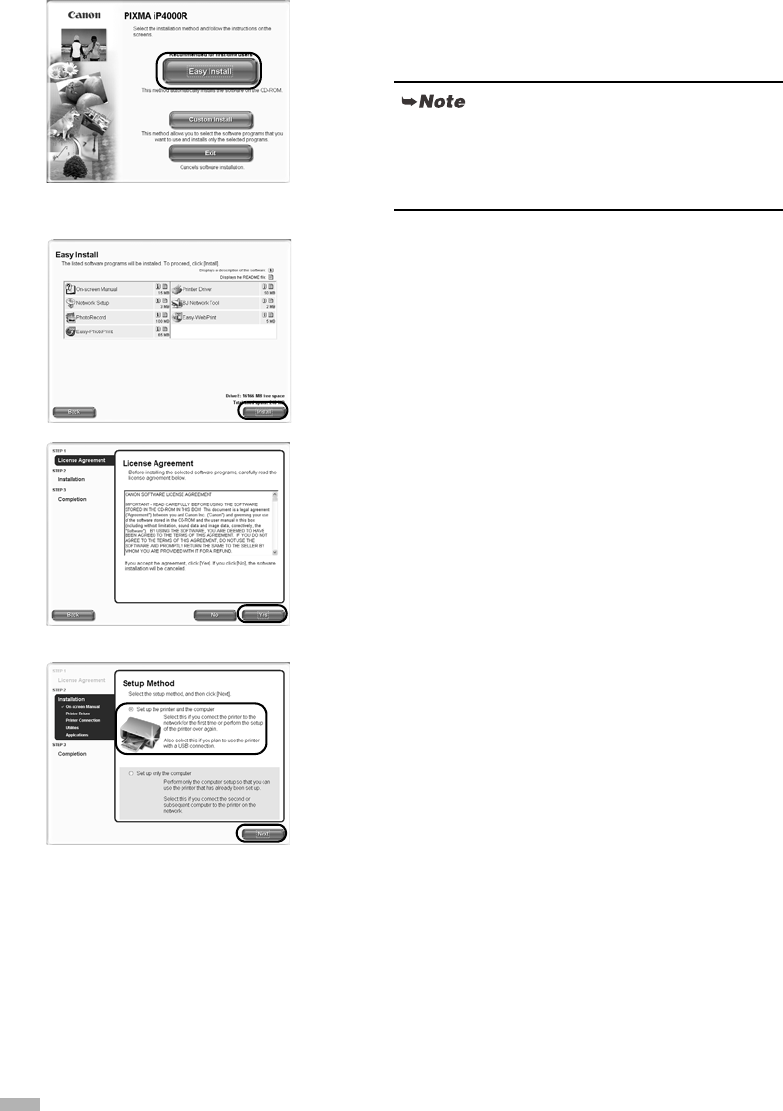
32
4
Follow the instructions displayed on
screen. When the screen shown on the
left is displayed, click Easy Install.
5
When the list of applications to install
appears, verify the contents, click
Install, then follow the instructions on
the screen.
6
Read the License Agreement carefully
and click Yes.
7
Select Set up the printer and the
computer and click Next.
When you select
Easy Install
, the items included in the
CD-ROM are installed automatically. To select
particular items to install, click
Custom Install
and
follow the instruction on the screen.
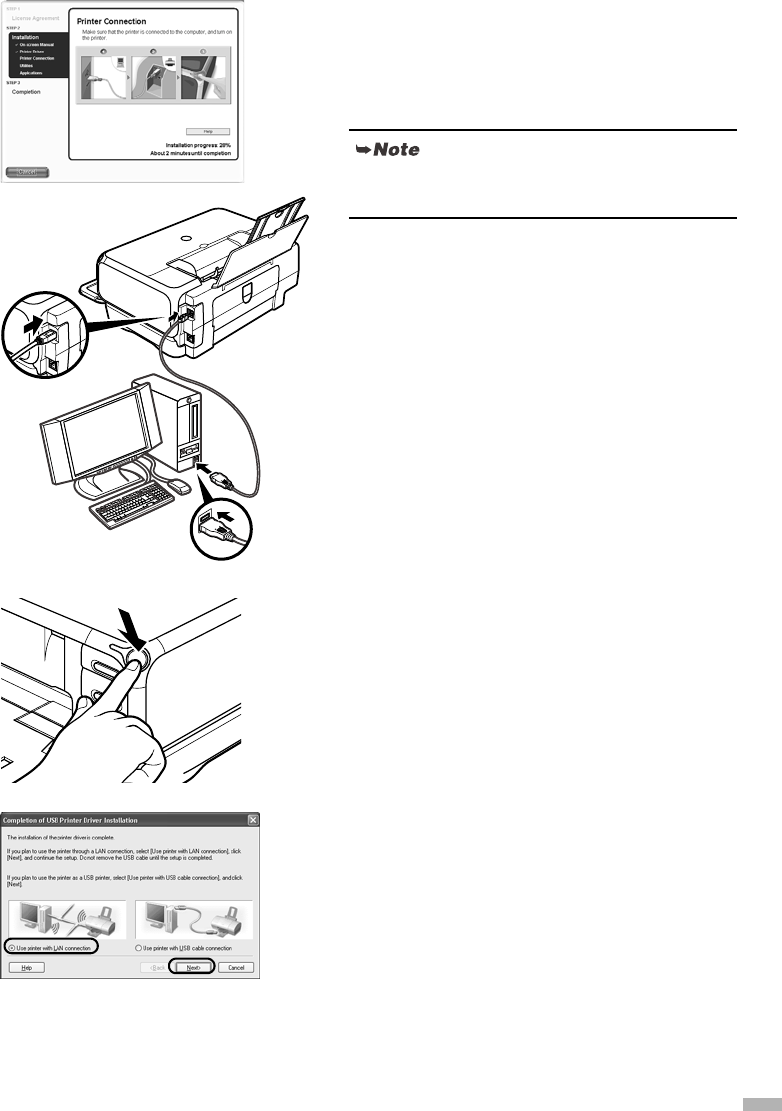
33
8
When the screen shown on the left
appears, connect the printer with a USB
cable and connect the printer to the
network devices such as hubs with an
ethernet cable.
9
Turn on the printer.
If the printer is recognized, the next screen will appear
automatically. If the connection is not recognized, click
Help
and follow its instructions.
10
Select Use printer with LAN
connection and click Next.
Connection may vary depending on your network
setup.
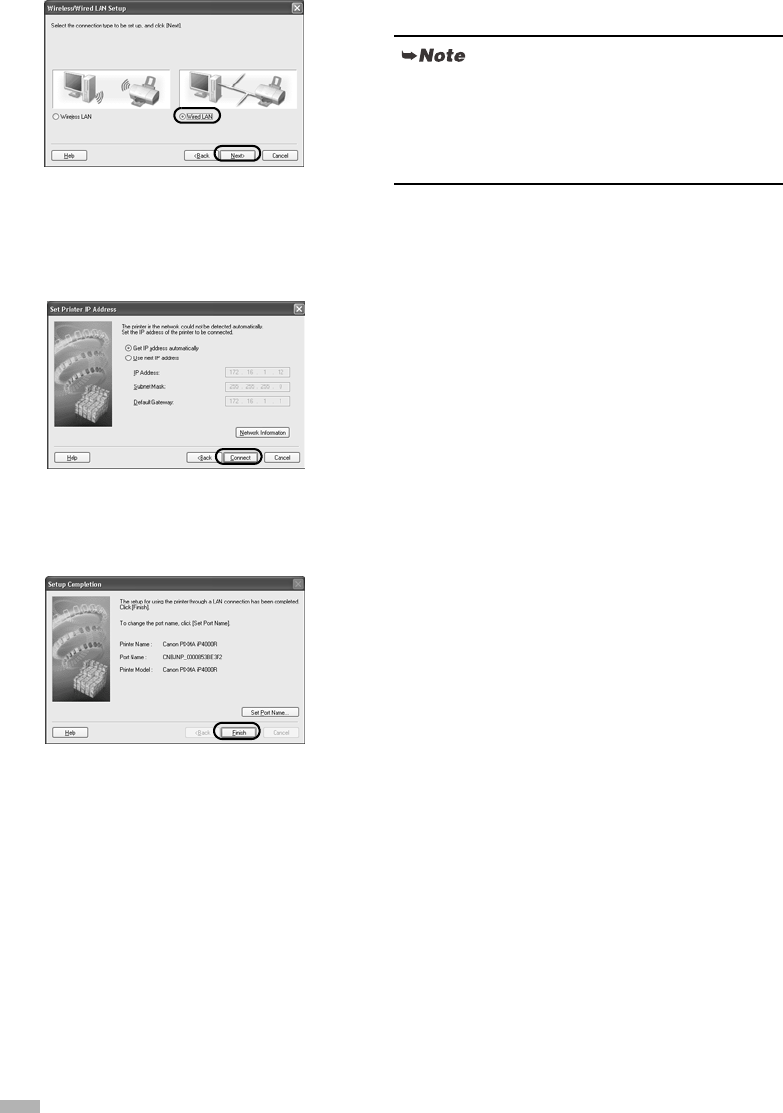
34
11
Select Wired LAN and click Next.
12
Setup automatically detects the printer.
The iP4000R connected with a USB cable is detected
automatically.
If the printer was not detected, the
Set Printer IP
Address
dialog box appears. Click
Connect
to retry
detection. If the printer is still not detected, take the
following measures.
• Ensure that the printer is on and connected to your
computer with a USB cable, then click Connect.
• Use manual searching. To confirm the IP address,
click Network Information in the Set Printer IP
Address dialog box. For details, see “The Set
Printer IP Address / Printer IP Address Setup dialog
box is displayed during setup” in
“Troubleshooting” on page 77.
13
Remove the USB cable, and click
Finish.
To change the port name, click
Set Port Name
. For
details, see “Changing the port name” in
“Troubleshooting” on page 81.
Setup will next install application programs.
If the printer’s network settings have been set before,
the
Printer Network Setup
dialog box is displayed.
For details, see“The Printer Network Setup dialog box
is displayed during setup” in “Troubleshooting” on
page 79.
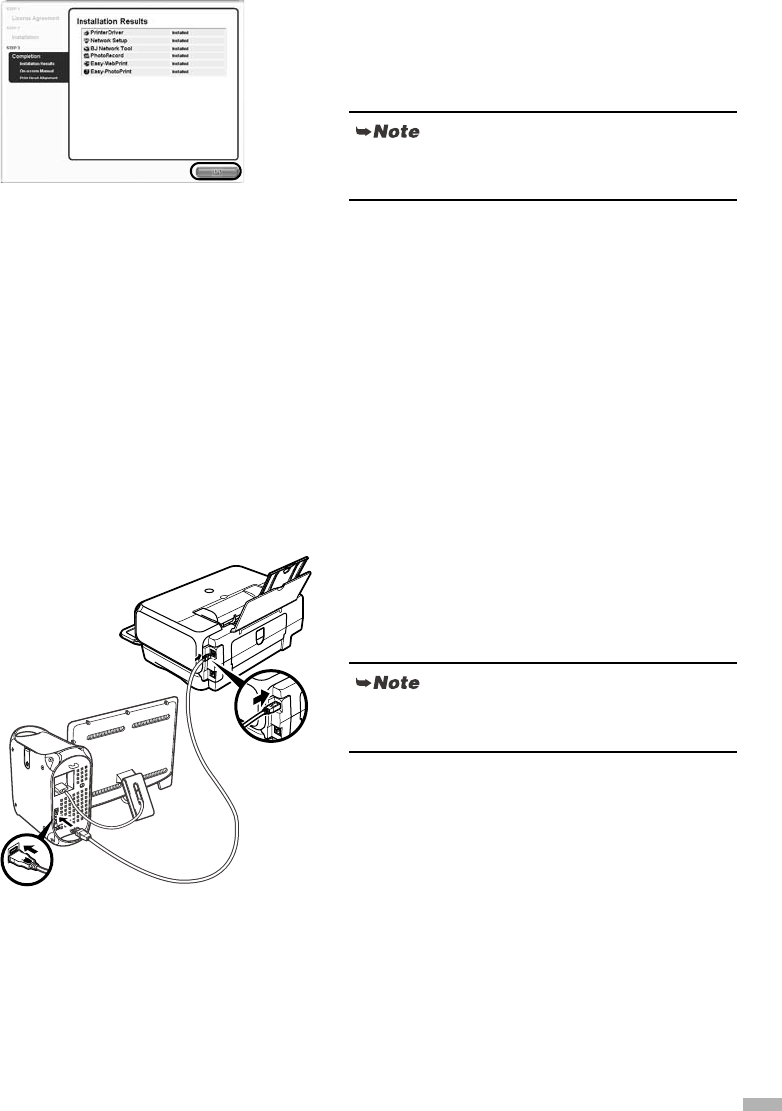
35
14
When the installation results are
displayed, click OK.
If you are prompted to restart the computer, click
Yes
and restart the computer.
15
When the On-Screen Manual dialog
box appears, click Next.
Printer software installation is now complete. Setup next
proceeds to perform print head alignment.
16
When the Print Head Alignment dialog
box appears, confirm that a sheet of A4
or Letter-sized plain paper is loaded in
the Sheet Feeder, and click Execute.
Go to step 5 of “Aligning the Print Head - Windows” on
page 52.
First-time Setup for Use over Wired LAN - Macintosh
1
Connect the printer with a USB cable
and connect the printer to the network
devices such as hubs with an ethernet
cable.
If the online registration dialog box appears, follow the
on-screen instructions to register your product.
Connection may vary depending on your network
setup.
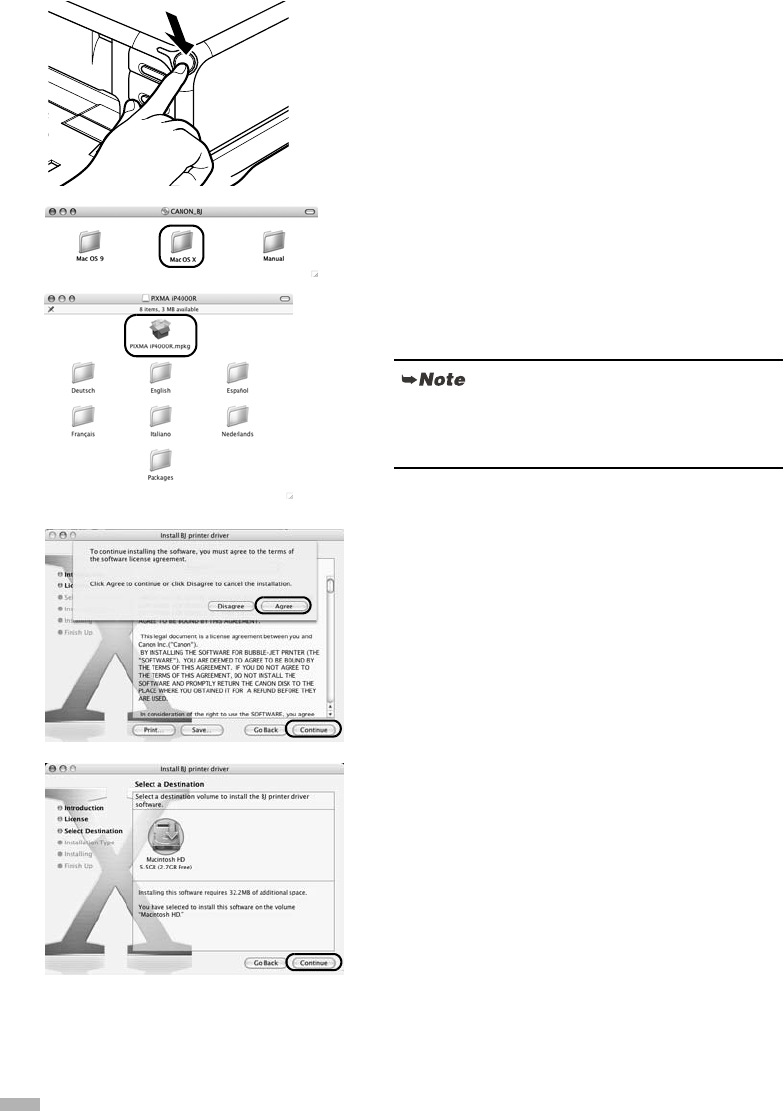
36
2
Turn on the printer.
3
Turn on the Mac.
4
Place the Setup Software & User’s
Guide CD-ROM in the CD-ROM drive.
5
Double-click the Mac OS X folder, then
double-click the Printer Driver folder.
6
Double-click PIXMA iP4000R xxx.pkg.
“x” represents a number.
7
Click Continue.
8
Read the License Agreement carefully
and click Continue, then click Agree.
9
Select a destination to where you want
to install the printer driver, and click
Continue.
10
Click Install.
When using Mac OS X v.10.2, go to step 12.
When using Mac OS X v.10.2, the
Authenticate
dialog
box appears. Enter the administrator’s name and
password, and click
OK
.
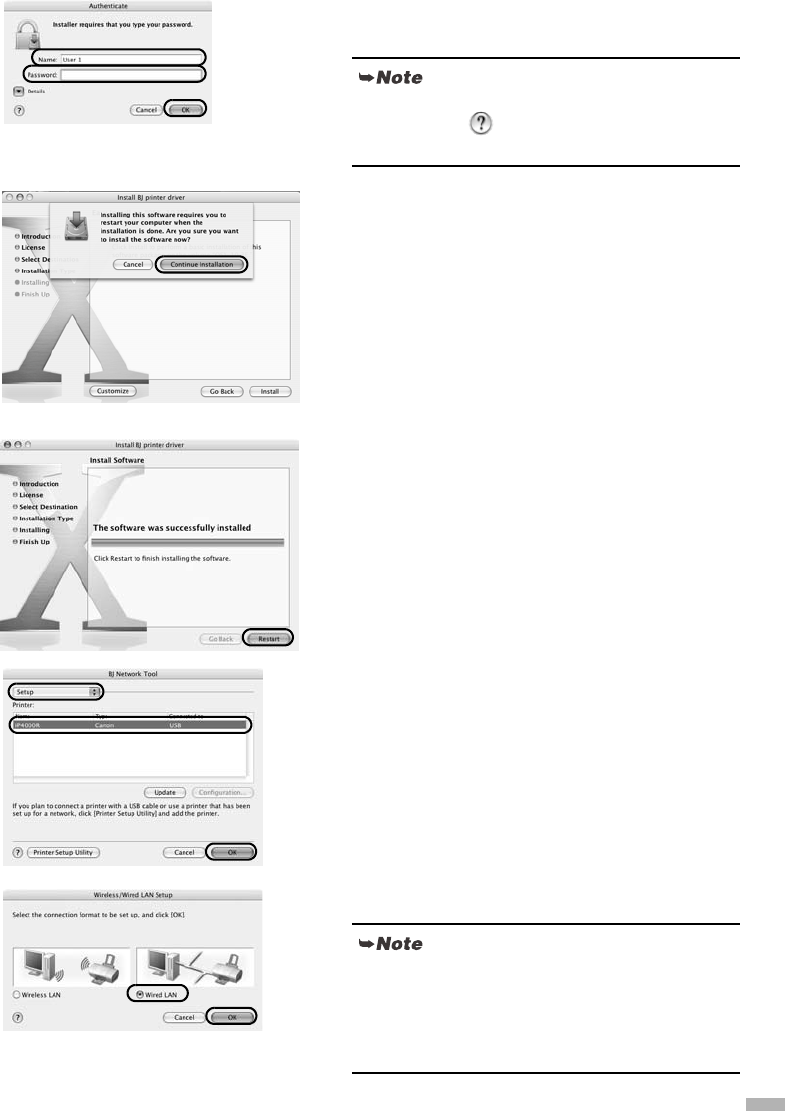
37
11
Enter the administrator’s name and
password, and click OK.
12
A message asking for your confirmation
to restart your Mac appears on the
screen. Read the message, then click
Continue Installation.
Software installation will start.
13
Click Restart.
When the computer restarts, BJ Network Tool will start
up. If it does not start automatically, select
Library
-
Printers
-
Canon
-
BJ Printer
-
Utilities
-
BJ Network
Tool
.
14
Select Setup from the pop-up menu
and iP4000R in Printer, then click OK.
If the
The printer could not be detected
message is
displayed, check that your printer is connected with a
USB cable and turned on, then click
Update
.
15
Select Wired LAN and click OK.
If you have forgotten the administrator name and/or
password, click and follow the instructions in
Mac
Help
.
If the printer’s network settings have been set
before, the Printer Network Setup dialog box is
displayed. For details, see “The Printer Network
Setup dialog box is displayed during setup” in
“Troubleshooting” on page 79.

38
16
Setup automatically detects the printer.
The iP4000R connected with a USB cable is detected
automatically.
If the printer was not detected, the
Printer IP Address
Setup
dialog box appears. Click
Connect
to retry
detection. If your printer is still not detected, take the
following measures.
• Ensure that the printer is on and connected to your
computer with a USB cable, then click Connect.
• Use manual searching. To confirm the IP address,
click Network Information in the Set Printer IP
Address dialog box. For details, see “The Set
Printer IP Address / Printer IP Address Setup dialog
box is displayed during setup” in
“Troubleshooting” on page 77.
17
Remove the USB cable and click OK.
The Printer Setup Utility (Print Center on Mac OS X
v.10.2) will start up.
18
Click Add.
19
Select CANON BJ Network from the
pop-up menu, select iP4000R from the
list of printers, and click Add.
The alphanumeric string after the printer name is its
MAC address.
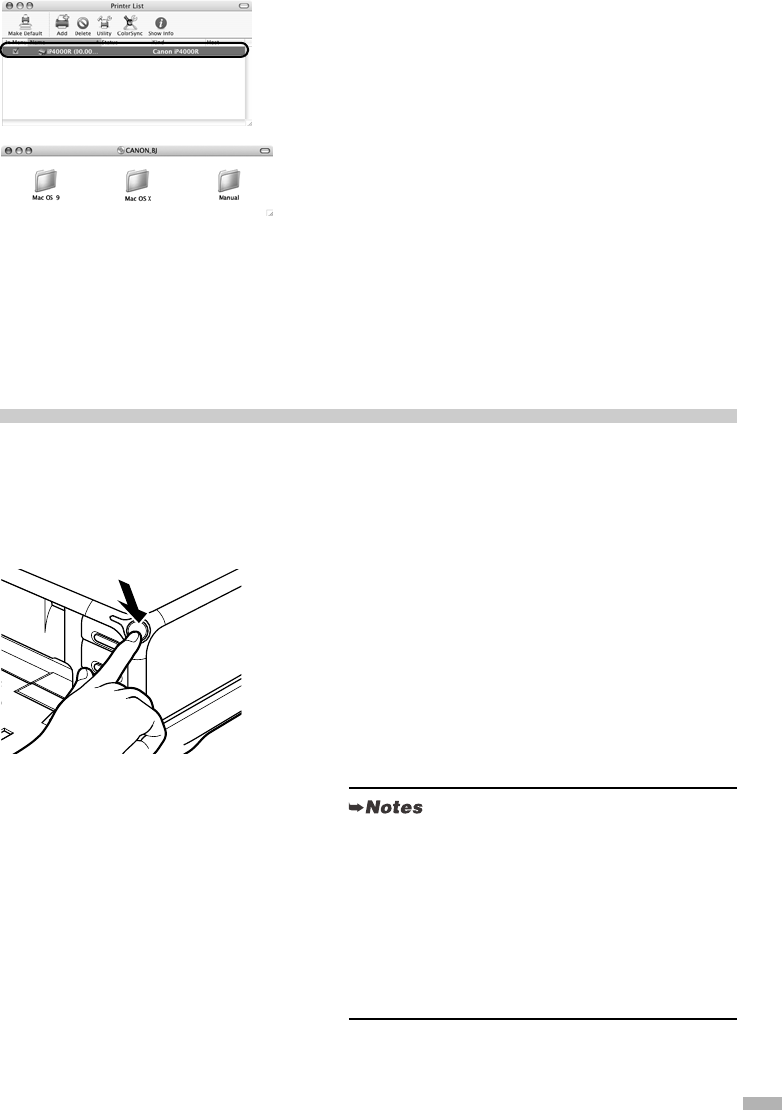
39
20
Confirm that your printer is added to the
list of printers.
Printer driver setup is now complete.
21
Install applications. In the Setup
Software & User’s Guide CD-ROM,
double-click CANON_BJ and then
double-click Application.
Double-click the installer in folder for each application
you want to install.
22
Perform print head alignment before
you start using your printer.
See “Aligning the Print Head - Macintosh” on page 53.
Setting Up for Use with USB Connection
When you are setting up the printer to be used as a standalone printer with USB connection, follow these
steps.
Setting Up for Use with USB Connection - Windows
1
Ensure that the printer and the
computer are turned off.
2
Turn on the computer and start
Windows. If any applications
automatically run, quit them.
Do NOT turn the printer on at this stage.
3
Place the Setup Software & User’s
Guide CD-ROM in the CD-ROM drive.
• If the CD-ROM does not run automatically, click
Start and select My Computer, then double-click
the CD-ROM icon. For non-XP Windows, double-
click My Computer in the Windows screen, then
double-click the CD-ROM icon.
• If the language selection screen appears, select the
language, then click OK.
• If the location selection message appears, select
your place of residence, then click Next.
OFF
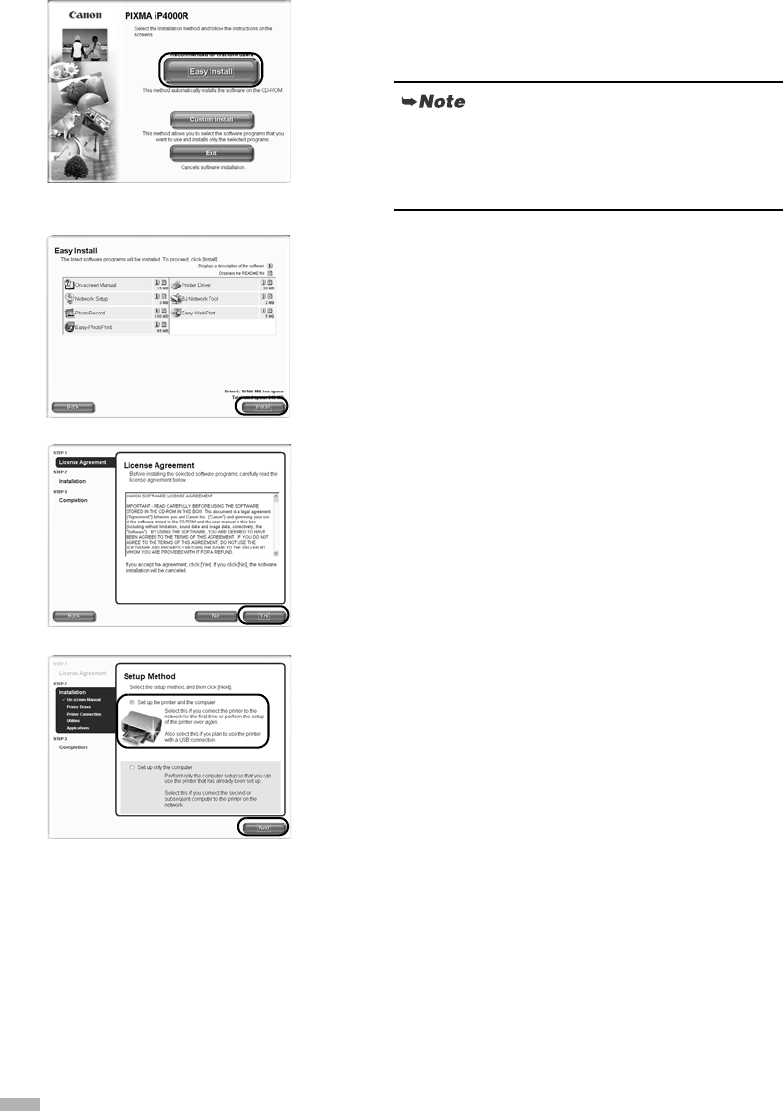
40
4
Follow the instructions displayed on
screen. When the screen shown on the
left is displayed, click Easy Install.
5
When the list of applications to install
appears, verify the contents, click
Install, then follow the instructions on
the screen.
6
Read the License Agreement carefully
and click Yes.
7
Select Set up the printer and the
computer and click Next.
When you select
Easy Install
, the items included in the
CD-ROM are installed automatically. To select
particular items to install, click
Custom Install
and
follow the instruction on the screen.
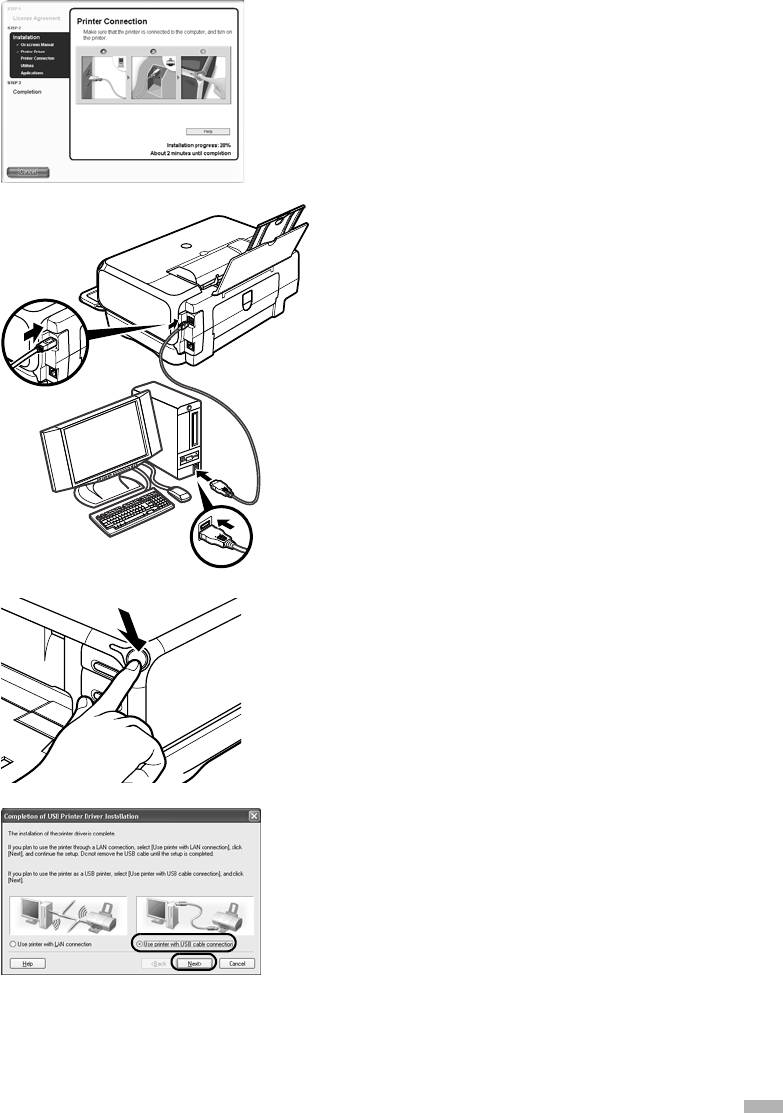
41
8
When the screen shown on the left
appears, connect the printer with a USB
cable.
9
Turn on the printer.
If the printer is recognized, the next screen will appear
automatically. If the connection is not recognized, click
Help
and follow its instructions.
10
Select Use printer with USB cable
connection and click Next.
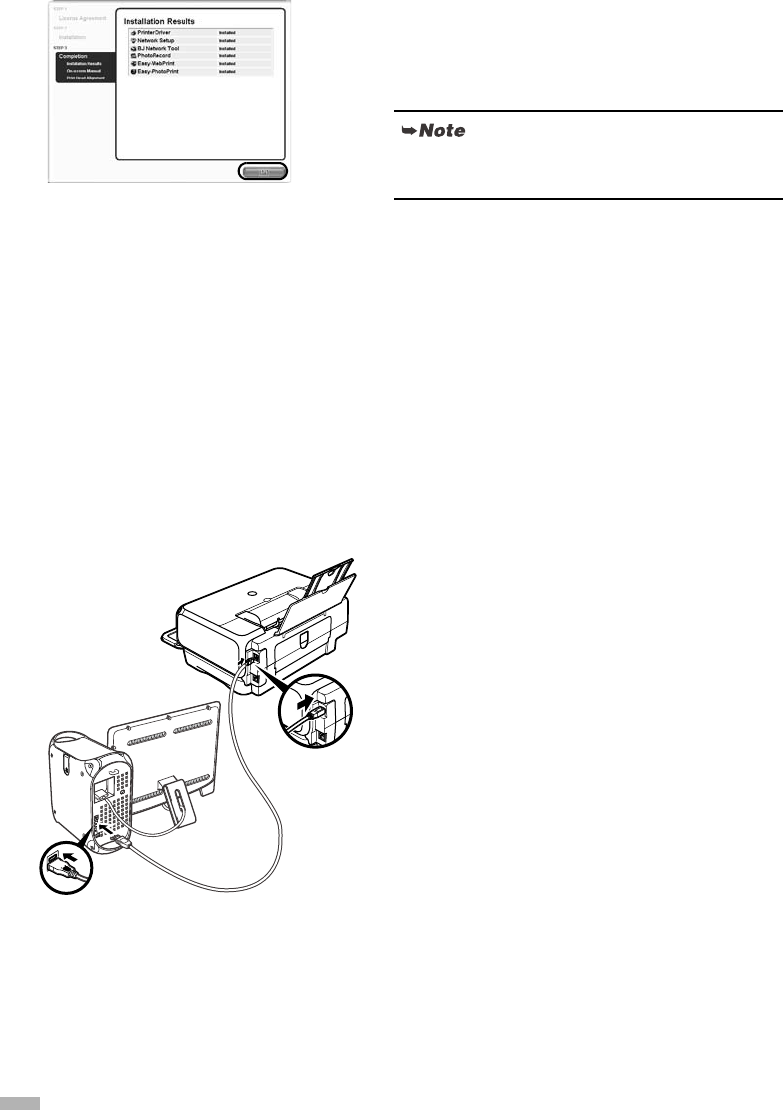
42
11
When the installation results are
displayed, click OK.
If you are prompted to restart the computer, click
Yes
and restart the computer.
12
When the On-Screen Manual dialog
box appears, click Next.
Printer software installation is now complete. Setup next
proceeds to perform print head alignment.
13
When the Print Head Alignment dialog
box appears, confirm that a sheet of A4
or Letter-sized plain paper is loaded in
the Sheet Feeder, and click Execute.
Go to step 5 of “Aligning the Print Head - Windows” on
page 52.
Setting Up for Use with USB Connection - Macintosh
1
Connect the printer with a USB cable.
If the online registration dialog box appears, follow the
on-screen instructions to register your product.